Animals That Start With B
June 18, 2020July 20, 2019 by C.B. Daniels
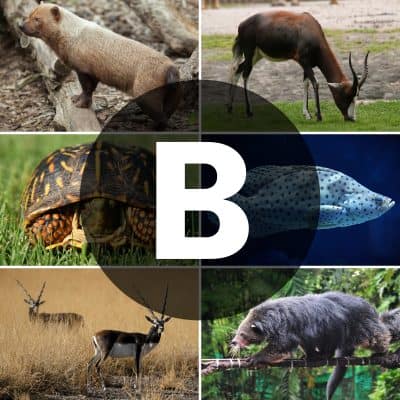

Here is our huge list of 70 animals that start with B! So, what kinds of animals begin with the letter B? Most people will quickly think of bees, bears, birds, baboons, or beetles. But did you know that there are over 16,000 different species of bees, eight species of bears, about 10,500 species of known birds, five species of baboons, and approximately 400,000 species of beetles? (Incidentally, the beetle/weevil order Coleoptera is the most significant order in the entire animal kingdom, comprising 25% of all known animals!)
TABLE OF CONTENTS
- Babirusa, North Sulawesi
- Bactrian Camel
- Badger, European
- Bald Eagle
- Ball Python
- Banded Bullfrog
- Banded Butterflyfish
- Banded Mongoose
- Banteng, Javan
- Barasingha
- Barbary Macaque
- Barber Pole Grasshopper
- Barn Owl
- Barramundi Cod
- Basilisk, Common
- Basking Shark
- Bat-eared Fox
- Bearded Dragon, Central
- Bearded Seal
- Beaver, North American
- Beluga Whale
- Bengal Tiger
- Betta
- Bettong, Tasmanian
- Big Brown Bat
- Bighorn Sheep
- Binturong
- Bison, American
- Black-backed Jackal
- Blackbuck
- Black Caiman
- Black-headed Bunting
- Black Rhinoceros
- Black Vulture
- Black Widow, Western
- Blesbok
- Blotched Blue-tongued Skink
- Blue-and-Yellow Macaw
- Bluebottle
- Blue Crab
- Blue-eyed Black Lemur
- Blue-footed Booby
- Bluegill
- Blue-throated Bee-eater
- Blue Whale
- Boa Constrictor
- Boat-billed Heron
- Bobcat
- Boll Weevil
- Bongo
- Bonobo
- Bottlenose Dolphin, Common
- Box Turtle, Common
- Brimstone, Common
- Broad-billed Hummingbird
- Brolga
- Brown Bear, Eurasian
- Brown-throated Sloth
- Brush Rabbit
- Buckeye
- Bufflehead
- Buff-tailed Bumblebee
- Bullet Ant
- Bull Shark
- Burchell’s Zebra
- Burgundy Snail
- Burmese Python
- Burrfish
- Bush Dog
- Bush Pig
At Animal Info World, information is king! Bearing this in mind, how could one possibly funnel 400,000 species down in a way that does any of them justice, and miss out on the rich diversity found between different species of the same genus?
Instead, each animal listed below is at the species or subspecies level of scientific classification, not merely a generic term you hear in everyday life. This approach allows us to take a deeper dive into the fascinating world we live in and truly stand in awe of our fellow planetary inhabitants, from the giant blue whale to the tiny boll weevil and the desert-trekking Bactrian camel to the artic-diving beluga whale. Let’s beegin!
Babirusa, North Sulawesi

Scientific name: Babyrousa celebensis
Also called: Deer-pig or pig-deer
Classification: Animalia>Chordata>Mammalia>Artiodactyla>Suidae>Babyrousa
Habitat: Tropical forests or near lakes on the Indonesian islands of Sulawesi, Lembeh, Buton, and Muna
Average lifespan: 10 years (wild), 23 years (captive)
Average adult size: 2 feet tall, 3 feet long body, weighs up to 220 pounds
Diet: Omnivore (leaves, berries, roots, mushrooms, bark, insects, fish, and small mammals)
Description: Babirusas have muddy-gray, rounded bodies covered in thick, wrinkled hides with very little hair. They have a long, pig-like snout, small, triangular ears, a thin tail with a small tuft of hair at the end, and slender, hooved legs. The males of the species have large canines along their top row of teeth, which form tusks protruding through the top of their snouts and curving backward towards their foreheads. On the bottom row, their canines also grow larger than the other teeth and curve, although not as dramatically. Females either have small tusks or lack tusks altogether. (Note: All living members of the Babyrousa genus were considered a single species up until 2002 when they were split into four separate species. This information is regarding the most commonly known species.)
Behavior: Babirusas forage in the morning and late afternoon, then lie down to rest for the remainder of the day. They have a keen sense of smell and utilize it to find their next meal. Males prefer solitude, whereas females form groups with their young. While they are not considered territorial, they do make long furrows in the ground and mark the area with their saliva, particularly males. Babirusas are swift runners and will swim if they need to, mostly in pursuit of food. No one knows for sure why male babirusas have such long tusks; some scientists believe they use their lower tusks for fighting (either over territory or a mate) while their upper tusks serve as a shield for their eyes. However, when observed in captivity, they rise onto their hind legs and box with their front hooves when confronted by another babirusa. (This is a wise choice because their tusks are not strong enough to handle blows and would likely break.) Regardless of its purpose, male babirusas must grind their tusks down regularly to avoid self-harm because an unchecked tusk can grow long enough to penetrate their own skull!
Fun Fact: “Babi-rusa” in Malay translates to “pig-deer” in English, so named because the natives believed their unique tusks resemble antlers.
Bactrian Camel
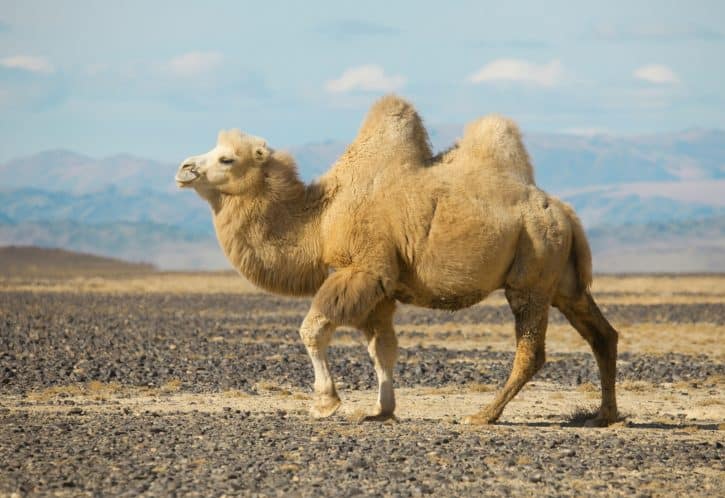
Scientific name: Camelus bactrianus
Classification: Animalia>Chordata>Mammalia>Artiodactyla>Camelidae>Camelus
Habitat: Migratory throughout central Asia and western China, from mountainous terrain to desert dunes
Average lifespan: 30 years
Average adult size: 7 feet tall (top of the hump), body 9 feet long, tail 18 inches long, weighs 1,000 pounds
Diet: Herbivore (grasses, grains, dried leaves, seeds, sticks, even a cactus here and there)
Description: Bactrian camels are the only species of camel that has two humps, making them easily identifiable. They are the largest living camels in the world, covered in shaggy, brown fur that ranges from light beige to dark brown. Their hair is often longer on the head, neck, humps, and forelegs. During the winter, their coat is heavier and is shed in clumps once spring returns, to avoid overheating. On their elongated faces they have large nostrils that can close shut, and two sets of eyelashes which come in handy for keeping sand out. They even have a clear membrane that covers their eye so they can see without getting an eyeful of sand. Bactrian camels have broad feet and are even-toed ungulates, which means they distribute weight evenly on their two toes.
Behavior: Highly adaptable to extreme weather, the Bactrian camel can withstand temperature ranges from -40° to 40° Centigrade (104° Fahrenheit) and has been used by humans as a pack animal since ancient times. Today, most of the 15 million Bactrian camels are domesticated. When they walk, they move two legs forward on the same side of their body at a time (called pacing), but they can also run up to 35 miles per hour and are able swimmers as well. Since water is usually scarce in the desert, whenever they can they will drink up to 30 gallons at a time. All camels have gotten a bad reputation for spitting; however, that’s not even the worst of it! It is not only saliva that they spray out of their mouths at a pesky onlooker, but stomach contents as well! Bactrian camels will “spit” to ward off a perceived threat but generally are docile animals.
Fun Fact: Most people think that water is stored in a camel’s hump; however, the humps consist of fatty tissue. These humps provide the energy they need to make long trips without food. You can tell how much reserves they have left by whether the humps are slumped and leaning to the side (running low) or sitting straight up (good to go).
Badger, European
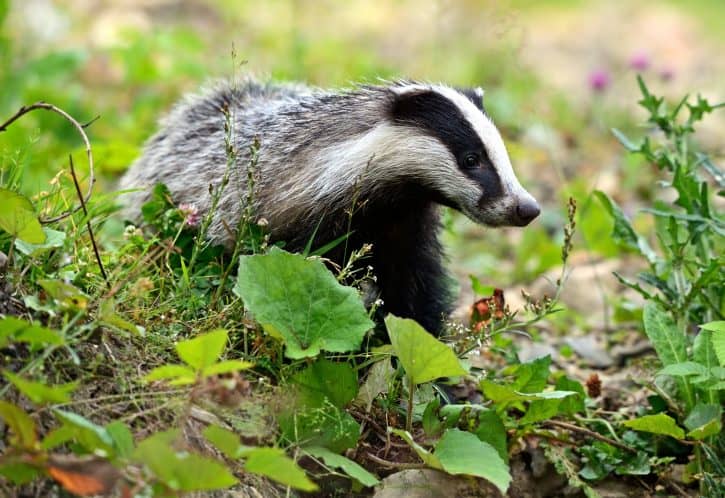
Scientific name: Meles meles
Also called: Eurasian badger, Asian badger, badger
Classification: Animalia>Chordata>Mammalia>Carnivora>Mustelidae>Meles
Habitat: Woodlands, scrublands, open pastures, suburban and urban areas throughout Europe and into western Asia
Average lifespan: 6 years (wild), up to 19 years (captivity)
Average adult size: Body 28 inches long, tail 15 inches, weight 22 pounds during spring or 35 pounds during winter (males weigh more than females)
Diet: Omnivore (fruit, nuts, acorns, tubers, earthworms, snails, insects, slugs, eggs, dead animal matter, small mammals like rats, voles, shrews, and frogs, snakes, lizards)
Description: European badgers have strong, wide bodies covered in very thick skin and coarse fur. Their fur is a salt-and-pepper coloring on their backs, black or dark brown on their undersides, with a distinct black and white striping on their heads from their nose to their ears. Their heads are elongated and supported by a strong neck, and their faces have small eyes, small tufted ears, and a whiskered snout. They have four short legs, and five toes on each paw, with the front paws contain long, curved claws used to dig in the ground.
Behavior: European Badgers are social creatures that are typically found in groups of up to 20, settling underground in burrows with elaborate tunnels and multiple exits. They are nocturnal and spend their days hidden away in these burrows, which are called setts. At night, they forage for food alone. Males can be aggressive and vicious during mating season, and these fights can be fatal. However, European badgers generally get along with each other and even groom one another. During the summer, they gain extra weight to get them through their winter sleep, which is not as deep as hibernation but instead is a period of less activity for them.
Fun Fact: European badgers are very tidy animals and make their own “toilets” far away from their homes. They also do not allow food to be brought into their home and regularly clean out their bedding, which is made from grass or hay.
Bald Eagle

Scientific name: Haliaeetus leucocephalus
Classification: Animalia>Chordata>Aves>Accipitriformes>Accipitridae>Haliaeetus
Habitat: Forests near rivers, lakes, and marshes throughout North America, from Canada and Alaska to northern Mexico (the highest concentration is found in Alaska)
Average lifespan: Up to20 years (wild)
Average adult size: Body 3 feet long, nearly 7-foot-long wingspan, weight 9 pounds (males) or 12 pounds (females)
Diet: Carnivore (mainly fish, but they also eat small mammals, turtles, snakes, crabs, animal remains, and other birds)
Description: Bald eagles have brown feathers everywhere but their heads and tails, which are covered in white feathers. A curved, yellow beak sits next to piercing yellow eyes on their faces, boasting eyesight so keen it can spot a rodent nearly 2 miles away. They have two small, yellow feet with sharp, black talons which are excellent for grabbing prey, both in the water and on land. And last but certainly not least, their two broad wings allow them to soar at speeds of up to 35 miles per hour and straight to the top of their food chain.
Behavior: As birds of prey, bald eagles hunt by flying through the sky, searching below for their next meal, and sometimes even stealing the catches of other birds. They are called sea eagles because they prefer to stay near bodies of water hunting for fish, which is their favorite. Their talons can hold up to four pounds in flight, so naturally they prey on smaller animals that they can carry back to their nests. Bald eagles are defensive when eating and will chase other animals off so they can finish their meal in peace. They are solitary hunters; however, they do mate for life and only take another mate when theirs dies. They produce several vocalizations, including a high-pitched screech believed to warn other animals that they are entering their territory.
Fun Fact: Ever wonder why they are called bald? Their name comes from the antiquated word “piebald,” which means “white-headed.”
Ball Python
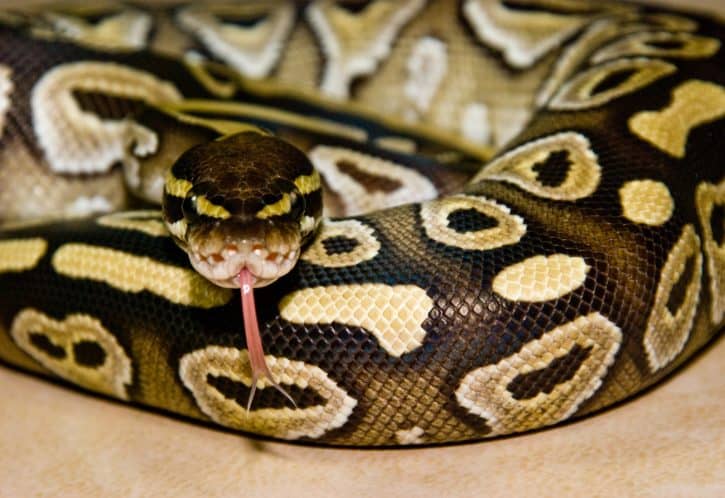
Scientific name: Python regius
Also called: Royal python
Classification: Animalia>Chordata>Reptilia>Squamata>Serpentes>Pythonidae>Python
Habitat: Savannas and forests of Sub-Saharan Africa: Senegal, Mali, Guinea-Bissau, Guinea, Sierra Leone, Liberia, Ivory Coast, Ghana, Benin, Nigeria, Cameroon, Chad, Central African Republic, Sudan, and Uganda
Average lifespan: 10 years (wild) or 30 years (captivity)
Average adult size: 4-4.5 feet long (females) and 3-3.5 feet long (males), 5 inches in diameter at the widest part
Diet: Carnivore (small mammals, birds, lizards, amphibians)
Description: Like all snakes, ball pythons have limbless bodies covered in scales. Their smooth scales are typically black or brown with light brown oval patterns along the top of their bodies, yellowish stripes from their nostrils to the end of their heads, and ivory-colored bellies. They have thick, heavy bodies that hold up a proportionally smaller, triangular-shaped head. On their faces are two lidless eyes, nostrils and a mouth, complete with rows of teeth instead of fangs. These timid snakes are commonly kept as pets, and there has been an increase in hybridization among breeders, yielding a wide array of unique coloration for potential pets.
Behavior: Ball pythons acquired their name due to their inclination to curl up into a ball when they feel threatened, with their bodies coiled snug around their heads for protection. They are most active at dawn and dusk. When they hunt, they settle down and hide, and use the element of surprise to strike and capture their prey. They are nonvenomous constrictors, which means they coil their bodies around their prey, squeezing it to death before eating it whole. In general, snakes do not rely solely on their noses to smell; instead, they smell and taste the air with each flick of their forked tongues. They also have sensors on their jaw that allow them to feel heat. Although they are able tree-climbers, ball pythons usually stay on the ground in the wild and will even burrow underground in the summer to aestivate. If you are thinking you might want a ball python as a pet, you can check out this guide.
Fun Fact: Why are they called royal pythons? Legend has it that Cleopatra wore ball pythons curled around her wrists, like jewelry.
Banded Bullfrog
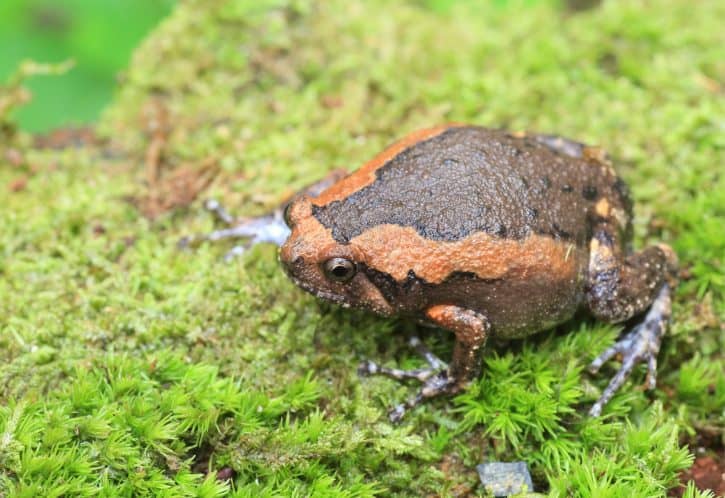
Scientific name: Kaloula pulchra
Also called: Chubby frog, Asian painted frog, rice frog, bubble frog, Asian bullfrog
Classification: Animalia>Chordata>Amphibia>Anura>Microhylidae>Kaloula
Habitat: Forest floors, overgrown lots, wetlands, rice paddies in south-east Asia (southern India, Sri Lanka, Burma, Thailand, Vietnam, Laos, Taiwan, Borneo, Java, Sumatra, Sulawesi, Flores, southern China)
Average lifespan: 10 years (wild)
Average adult size: 2-3 inches long (females are generally larger than males)
Diet: Carnivore (Primarily ants and termites, then flies, crickets, moths or earthworms)
Description: Banded bullfrogs are round frogs with dark brown bodies and cream-colored bellies. They are recognizable by the light brown, orange or salmon-colored stripes running across their foreheads and down the sides of their bodies. Some frogs also have dark or cream splotches randomly on their legs or backs. They have bumpy skin and four long, hinged legs with widespread toes which are typically lighter in color than their backs. Their faces have large round eyes, a short nose, narrow mouth, and no neck, making them appear chubby as their nickname implies. Males have darker-colored throats than females.
Behavior: Banded bullfrogs spend most of their days buried under leaves, in holes, or rice fields and tend to come out after it rains. They love to eat, yet move slowly, so most of their prey are slow movers too. If they feel threatened, they puff up their bodies and secrete a toxic, sticky substance out of their skin to defend themselves. During mating season, males puff themselves up even more, including their throats, and produce a bellowing cattle-like croak to attract females. They are described as looking like a ball with legs when in this state, and therefore earned their nickname “bubble frog.”
Fun Fact: Ants won’t go marching on and on with banded bullfrogs around! They have been observed eating ants one by one from behind as they walk in their lined formation.
Banded Butterflyfish
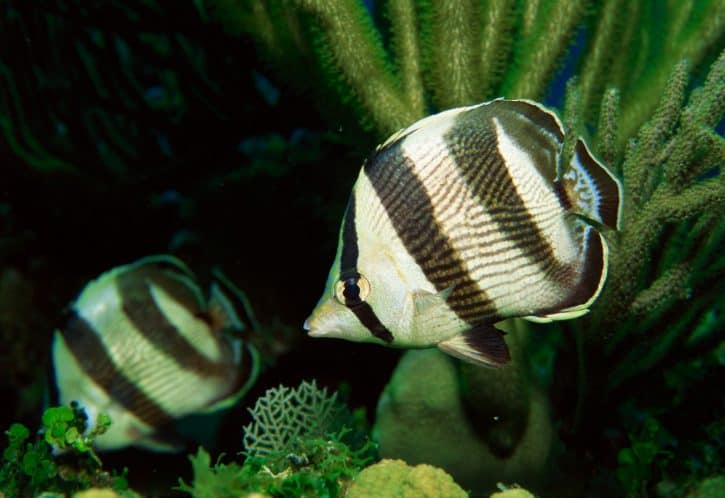
Scientific name: Chaetodon striatus
Also called: Butterbun, butterflyfish, Portuguese butterfly, banded mariposa, school mistress
Classification: Animalia>Chordata>Actinopterygii>Perciformes>Chaetodontidae>Chaetodon
Habitat: Tropical and subtropical waters of the Atlantic Ocean, from the northwestern United States to the westernmost point of Brazil, as well as the Gulf of Mexico and Caribbean Sea (depth range from 65 feet to 180 feet)
Average lifespan: 7 years (wild) or 10 years (captivity)
Average adult size: Up to 6 inches long
Diet: Carnivore (tiny invertebrates, crustaceans, tubeworms, corals, anemones, parasites)
Description: Banded butterflyfish have thin, silver-white bodies with four black, vertical stripes. The stripe on the face crosses over the eye, the two stripes in the middle are the widest and the stripe at its rear blends in with the end of its body and sometimes overlaps with the third stripe. Banded butterflyfish have two pectoral fins on either side of their body, a dorsal fin that contains 12 spines and about 20 rays, an anal fin that has three spines and 16-17 rays, and a triangular tailfin. The rounded dorsal and anal fins are black with a striking white outline while the tailfin has varying black and white stripes. Their heads are triangular with their tiny mouth at the point, full of bristle-like teeth.
Behavior: Butterflyfish are often found foraging in pairs around coral reefs. They have also been observed in groups of up to 20, hunting plankton, or individually functioning as cleaner fish by eating parasites off the scales of larger fish. They are active during the day and find a safe place to sleep at night, away from night predators. In captivity, they are not aggressive and generally get along well with other fish, making them a popular choice for aquarium owners.
Fun Fact: The black stripe that crosses through their eye confuses predators that don’t know if the fish is coming towards them or ready to escape from them!
Banded Mongoose

Scientific name: Mungos mungo
Classification: Animalia>Chordata>Mammalia>Carnivora>Feliformia>Herpestidae>Mungos
Habitat: Northern savannas of Western Africa, Central and Southeastern African savannas, brushlands and grasslands
Average lifespan: 10 years (wild), 15 years (captivity)
Average adult size: Body 15 inches long, tail 9 inches long, weighs 4 pounds
Diet: Omnivore (beetles, millipedes, other insects, lizards, birds, snakes, fish, rodents, frogs, worms, fruit, nuts, berries, roots, and stolen eggs)
Description: Covered in brown-gray fur, banded mongooses are distinguishable by the multiple dark stripes in horizontal rows across their backs. They have strong, slender bodies and a curved back when they walk on all fours. Their long, black-tipped tail tapers down in size and is not striped. On their faces, they have sloped foreheads leading to pink noses and a lightly whiskered muzzle. Red-brown eyes sit close to their semi-circular ears, which are tufted with longer hair in front. Their thin non-retractable claws are perfect for digging in search of bugs and lizards.
Behavior: The banded mongoose is a communal mammal and lives in groups of 10 to 50 mongooses. They are diurnal, and spend their days foraging for food, helping each other raise young, chattering to each other, eating, and resting. At night they gather together, usually in termite mounds, and apply the “safety in numbers” rule for the night. Should they be attacked, they will work as a team to overcome the threat. They do not stay in one spot for more than a week at a time and stick together in their travels. Although they are loyal to their own groups, they can be highly aggressive if they come across another group.
Fun Fact: Many people think that all mongooses are immune to all snake venom. This is a common misconception; the reality is that some mongooses naturally possess a natural resistance to the venom of certain snakes, such as the Indian Gray mongoose’s resistance to a King Cobra snake’s venom.
Banteng, Javan

Scientific name: Bos javanicus javanicus
Also called: Tembadau
Classification: Animalia>Chordata>Mammalia>Artiodactyla>Bovidae>Bovinae>Bos javanicus
Habitat: Grasslands, savannas, and tropical moist or dry forests throughout the Indonesian islands of Java and Bali
Average lifespan: 20-25 years (captivity) or 15 to 20 years (wild)
Average adult size: 5 feet tall (shoulder), body 8 feet long, 2-foot-long horns, 2-foot-long tail, weight 1,400 pounds
Diet: Herbivore (grass, fruit, leaves, branches, bamboo)
Description: Banteng are short-haired cattle that have a hump above their shoulders and coloring that depends on whether they are male or female. Males have black hair, while females have buff coloring with a dark stripe along the backbone. Both males and females have horns. Males have larger, darker horns that point straight up when fully grown, while females have shorter, typically lighter colored horns that point towards each other at the top. The white hair above their eyes, and on the muzzle, legs, and rumps of both sexes is a defining feature of the species. Their faces feature a rounded, black snout, sparsely haired muzzle, and large, white-tufted ears that sit horizontally beside their eyes. They also have long, thin tails with a tuft of black hair at the end.
Behavior: Bantengs are timid, elusive creatures that are usually equally active during the day and night, unless there is a substantial human presence when they become more active at night. As one of the last species of wild cattle, they group together in herds of up to 30 with only one adult bull that mates with all the adult females in his herd. The other males form bachelor groups or remain solo. Bantengs are an endangered species and can often be found in protected areas such as national parks and wildlife reserves. Even so, the domestic population in south-east Asia contains roughly 1.5 million bantengs, which are called Bali cattle and are either used for their meat or as working animals.
Fun Fact: The banteng is the only endangered species to live more than a week after being successfully cloned. In fact, the clone ended up living for seven years in the San Diego Zoo.
Barasingha
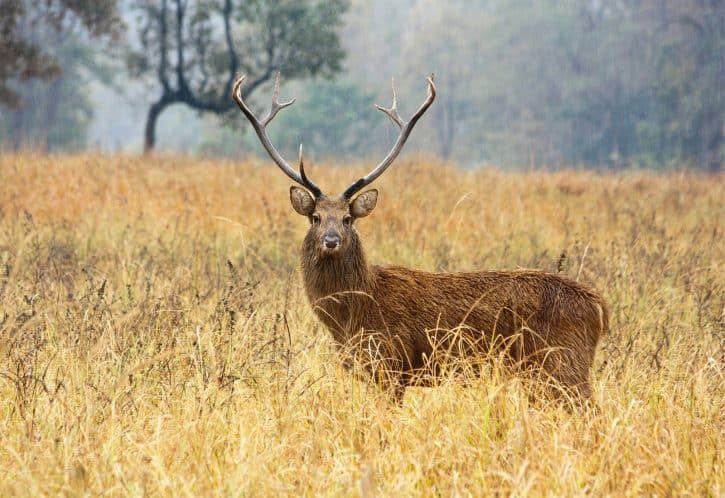
Scientific name: Rucervus duvaucelii
Also called: Swamp deer, graceful deer
Classification: Animalia>Chordata>Mammalia>Artiodactyla>Cervidae>Rucervus
Habitat: Tall grasslands, open forests, swamps and marshes in northern and central India, as well as southern Nepal
Average lifespan: 20 years (wild), up to 23 years (captive)
Average adult size: Nearly 4 feet tall (shoulder), antlers 30 inches round the curve with 5-inch girth at mid-beam, 6-foot long body, weighs 300 pounds (female), 500 (males)
Diet: Herbivore (grass, leaves, and aquatic plants)
Description: Barasinghas are large deer with wooly coats that are usually an orange-brown or yellow-brown color with white spots visible along its spine. A female’s coat tends to be lighter than a male’s, while males are further distinguishable by their elaborate antlers boasting 10 to 20 tines. (In contrast, all other Indian deer have only three tines.) Their throats, bellies, inside of their thighs and underside of their tails are a creamy white color. They have small heads with round, black snouts, and muscular bodies with long, thin legs.
Behavior: Barasinghas are highly social and can be found in average group sizes of 20 deer, with breeding groups containing up to 60 members. These groups contain twice as many females as males and are mostly the same age. Males are not as loyal to the herd as the females and roam from herd to herd. Dominant males will fight each other by clashing antlers over access to a harem of up to 30 females. Barasinghas graze throughout the day, with peak eating times in the morning and late afternoon to evening. Should a predator approach, they bark and scream to alarm the other members of the herd, as well as stomp their feet. As the most vulnerable deer in the world, many Barasinghas live in Indian reserves and national parks for protection.
Fun Fact: Barasingha means “twelve-tined” in Hindi, so named because the adult males have an average of twelve tines on their antlers.
Barbary Macaque

Scientific name: Macaca sylvanus
Also called: Barbary ape, rock ape
Classification: Animalia>Chordata>Mammalia>Primates>Haplorhini>Similiformes>Cercopithecidae>Macaca
Habitat: Forests, mountains and cliffs of the Atlas and Rif Mountain ranges in Algeria and Morocco; and a small group in the Gibraltar Nature Reserve
Average lifespan: 25 years (males), 30 years (females)
Average adult size: 2 feet tall, tail length between 4-22 cm (longer in males than females), weight 22 pounds (female) or 32 pounds (male)
Diet: Omnivore (acorns, bark, lichen, flowers, caterpillars, frogs, mushroom, insects, fruit, seeds, roots)
Description: Even though they are called Barbary apes, they are one of the few monkey species that lacks a distinguishable tail. (Although it is only 1 to 2 cm long and hidden by their fur, they do have tails.) Barbary macaques are Old World monkeys covered in thick, yellowish gray to brown fur everywhere but their pink faces. The underside of their bodies is a lighter cream color, and their arms are longer than their legs. They have hidden cheek pockets which allow them to store food while foraging and can hold as much food as their stomachs!
Behavior: Barbary macaques are most active during the day and sleep in the nighttime in same-sex groups of 2-3. They are very social creatures and live in groups of up to 80 monkeys, often led by a female. Should a threat approach, they will let out a unique alarm call to warn the rest of the group. They practice group grooming as a form of hygiene, bonding, and stress relief. In contrast to other primates where the mother is the primary caretaker of her young, the males of this species are active caregivers even if they are not the father of the infant. The very young are treasured and watched over by all members of the group.
Fun Fact: The Barbary macaque is the only species of macaque found outside of Asia and the only wild monkeys found in Europe. Talk about a special species!
Barber Pole Grasshopper

Scientific name: Dactylotum bicolor
Also called: Painted grasshopper, rainbow grasshopper, pictured grasshopper, Uncle Sam grasshopper
Classification: Animalia>Arthropoda>Insecta>Orthoptera>Acrididae>Melanoplinae>Dactylotini>Dactylotum
Habitat: Prairies, desert grasslands, alfalfa fields, and sparsely vegetated areas in the western United States, southern Canada, and northern Mexico
Average lifespan: About 1 year (from egg stage)
Average adult size: 0.8 inches (males), 1.4 inches (females)
Diet: Herbivore (a wide variety of grasses, non-grasses/forbs, leaves)
Description: Like all grasshoppers, the bodies of barber pole grasshoppers have short antennae, a head containing compound eyes, a thorax containing two sets of short legs used for walking, and abdomen in the back, containing one set of long, hinged legs used for jumping. Barber pole grasshoppers are typically banded in black or dark blue and off-white, with red, orange, or yellow markings. Their underbellies and wing pads are a pale green color. Overall, the detail of their coloring makes them look like little works of art, hence the name “painted grasshopper.”
Behavior: This species of grasshopper does not develop wings so it cannot fly like other grasshoppers, thereby limiting their ability to migrate to other areas. Instead, they use their six legs to walk or jump, depending on the circumstance. To feed, they utilize their jaws to rip pieces of plants off, and their palps function like hands to grab and move their food to their mouths. After breeding, the barber pole adult grasshoppers stay close to their nymphs. Most numerous from late July through September, adults typically only live for two months, with the females dying shortly after finishing laying eggs.
Fun Fact: The barber pole grasshopper’s colors are useful in keeping predators away; lizards find them unattractive and won’t eat them, and birds recognize their warning coloration as unappetizing.
Barn Owl

Scientific name: Tyto alba
Also called: Common barn owl, white owl, hissing owl, screech owl, silver owl, ghost owl, demon owl, straw owl, barnyard owl, death owl, night owl, delicate owl, white-breasted owl, stone owl, cave owl, church owl, rat owl, hobgoblin owl, monkey-faced owl, scritch owl
Classification: Animalia>Chordata>Aves>Strigiformes>Tytonidae>Tyto
Habitat: Worldwide in trees, caves or crevices near forests, grasslands, farmlands, deserts, as well as human-made structures like barn lofts and church steeples
Average lifespan: 4 years (wild)
Average adult size: Body and tail 14 inches long, wingspan nearly 3 feet long, weight varies between subspecies from a half-pound to 1.5 pounds
Diet: Carnivore (mainly voles, mice and shrews but also bats, birds, insects, frogs, and lizards, depending on where they live)
Description: Barn owls have unique, heart-shaped faces covered in fluffy, typically white feathers, two small black eyes, and a small, often pale beak that looks longer than it is, like a nose. Hidden under the feathers near their eyes are asymmetrical ears which allow them to isolate sounds above and below them. Their bodies are covered in feathers that range in color from light brown to gray to dark brown, and they typically have small spots of varying size on the top of their bodies. Their boxy tail and the lower feathers on their wings are striped. Like all birds of prey, they have sharp talons and keen eyesight used during hunting.
Behavior: Barn owls are not considered territorial, but they stay near their home range and prefer to hunt close to forests and near the edges of fields. These typically nocturnal hunters fly slowly and silently, relying mostly on their sharp sense of hearing to swoop down in the dark and grab their prey off the ground. They do not hoot; instead, they screech, hiss or twitter, depending on the circumstance: hissing when threatened, twittering when courting another owl. After courting, barn owls mate for life and will only take a new mate if theirs dies.
Fun Fact: The barn owl is the most widely distributed land-dwelling bird in the world and found on every continent except Antarctica.
Barramundi Cod
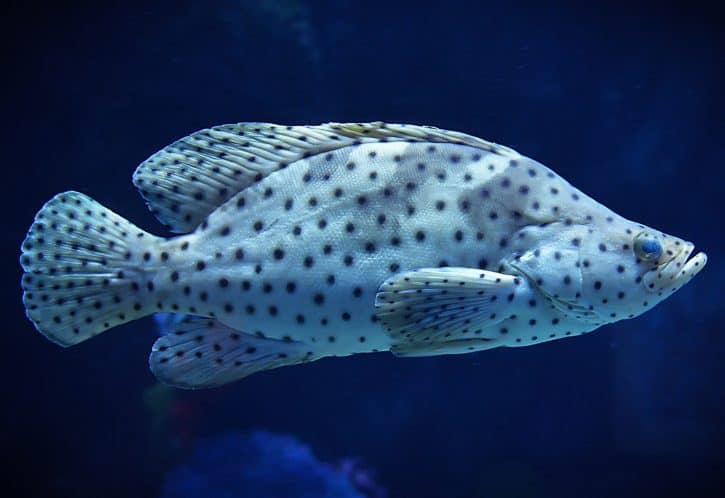
Scientific name: Cromileptes altivelis
Also called: Humpback grouper, panther grouper, polka dot grouper
Classification: Animalia>Chordata>Actinopterygii>Perciformes>Serranidae>Epinephelinae>Cromileptes
Habitat: Tropical and subtropical waters in the central Indo-West Pacific area, specifically lagoons and seaward reefs (depth range from 6 feet to 130 feet)
Average lifespan: 20 years (wild)
Average adult size: Up to 28 inches long, average weight is not readily available however the full-grown adult caught in Florida in 2012 was 15 pounds
Diet: Carnivore (smaller fish, squid, and crustaceans)
Description: The unique profile of the barramundi cods makes them easy to identify. They have long, sloping foreheads and pronounced snouts giving them a humpback appearance, hence the nickname. Their bodies range in color from gray to beige with splotches that are slightly darker in color, and small, dark spots cover the entire body, including the fins. Two pectoral fins, a long, mohawk-like dorsal fin, a rectangular tailfin, and small anal fin allow the fish to maneuver in the water.
Behavior: Barramundi cods are highly aggressive, territorial groupers. They are ambush predators that blend in with their environment and wait for the perfect moment to capture their prey. They are swift swimmers and use speed when hunting and avoiding predators. They can be found hunting at sunrise and sunset and are usually found alone unless it is time to mate. Due to their aggressive nature, demanding diet and large size, they are typically not kept as pets in aquariums.
Fun Fact: All barramundi cod are protogynous hermaphrodites, which are animals that are all born as females and later in life can become a male.
Basilisk, Common
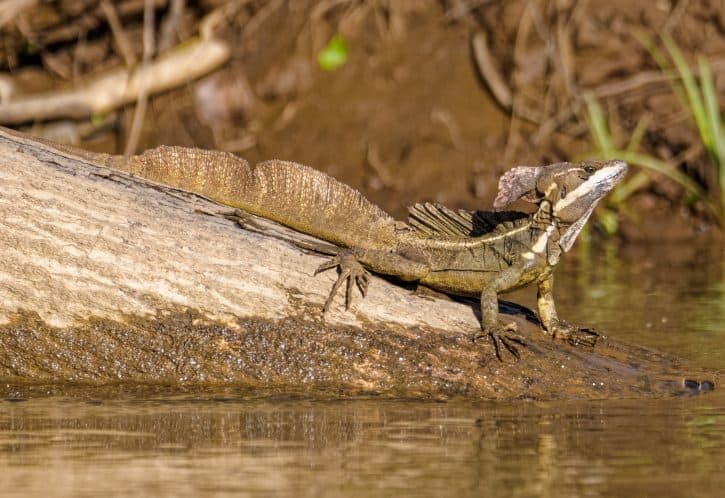
Scientific name: Basiliscus basiliscus
Also called: Jesus Christ lizard, South American Jesus lizard, Jesus lizard
Classification: Animalia>Chordata>Reptilia>Squamata>Iguania>Corytophanidae>Basiliscus>Basiliscus
Habitat: Near rivers and streams in Central and South American rainforests
Average lifespan: 7 years (captivity), 5 years (wild males) or 4 years (wild females)
Average adult size: 1-2.5 feet long (tail included, accounting for 75% of its size), weighs 21 ounces (males) or 10.5 ounces (females)
Diet: Omnivore (insects, fruit, flowers, eggs, small invertebrates such as birds, fish, and snakes)
Description: Common basilisks are large lizards that are typically olive green, bronze, or brown, with white, cream or yellow stripes and dark bands on their bodies. The most prominent stripe runs along the face above the lip and stops near its shoulder on each side, while the secondary stripe starts behind the eyes and runs (as a broken or unbroken line) down its back on both sides of the body. They have additional striping on their throats and the top of their heads. They have big brown or green eyes, a large mouth with hidden serrated teeth, distinct fin-like crests on their backs, and widespread finger-like claws at the end of each leg. The males have two additional crests, one on the head and one on the tail.
Behavior: Common basilisks spend their days foraging and hunting for food, basking in sunlight, and rest high up in the trees at night. They protect themselves from predators by burrowing under fallen leaves on the ground, blending in with their surroundings and staying still until the threat has moved on. They are expert climbers and swimmers, although they tend to stay out of the water to avoid being eaten by larger reptiles. The common basilisk is called the Jesus Christ lizard because it appears to walk across the surface of the water when chasing prey or fleeing from a predator. It accomplishes this feat by running on its hind legs only, at a speed of about 5 feet per second and a max distance of 15 feet. To learn more about how they can run on water, click here.
Fun Fact: Basilisks got their name from the Greek word Basiliskos, which means “little king.” It is believed that the name was chosen because the crest the males have on their heads resembles a crown.
Basking Shark
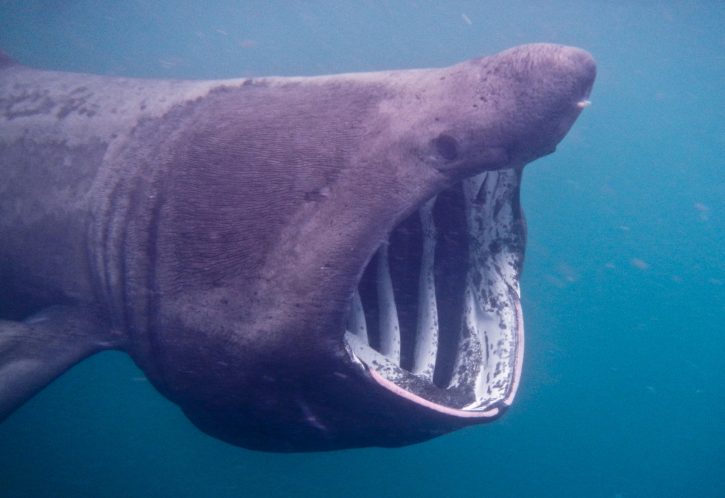
Scientific name: Cetorhinus maximus
Classification: Animalia>Chordata>Chondrichthyes>Lamniformes>Cetorhinidae>Cetorhinus
Also called: Elephant shark, bone shark, sail-fish, sun-fish
Habitat: Temperate ocean waters around the world, along what is called the Continental Shelf (depth range from the surface to 3,000 feet minimum)
Average lifespan: Estimated at 50 years, but it is not known for sure
Average adult size: 23 feet long, jaw just over 3 feet wide, weighs 5.2 tons
Diet: Carnivore (zooplankton, tiny fish, other invertebrates, whatever is edible in front of them when they are swimming forward with their mouths open)
Description: Basking sharks are often a mottled grey-brown color, although they can be black or blue, with lighter coloration on their bellies. They have the trademark triangular dorsal fin associated with sharks, but they also have a unique tailfin shaped like a crescent moon, two pectoral fins that can be up to 6 feet long, and four smaller fins at the rear of the body. Their bodies are slightly wrinkled with elongated snouts sitting above enormous mouths. On the sides and bottom of their heads are large gill slits. Each gill slit is equipped with gill rakers, containing thousands of tiny, hooked teeth that keep anything that is not water from escaping. With gill rakers containing about 100 teeth per row, basking sharks have more teeth than any other living shark.
Behavior: Basking sharks are known for being ram feeders: swimming forward slowly with their mouths wide open, capturing anything that didn’t swim away along with surrounding water, then retaining prey while filtering the water out of their gills. They only swim like this for a few minutes at a time, swallow their food, and start over again. They are usually spotted hunting alone but can also be seen in groups as well. Active year-round, they have no problem following plankton into warmer, shallow water and even got their name because of their inclination to feed near the surface, seemingly basking in the sun. During winter, they dive deeper in the water, up to 3,000 feet, in search of deep-water plankton. Even though they are huge sharks, they can breach, jumping entirely out of the water!
Fun Fact: The basking shark is the second-largest fish in the world, behind the whale shark. They are also one of only three plankton-eating sharks, the other two being the whale shark and the megamouth shark.
Bat-eared Fox
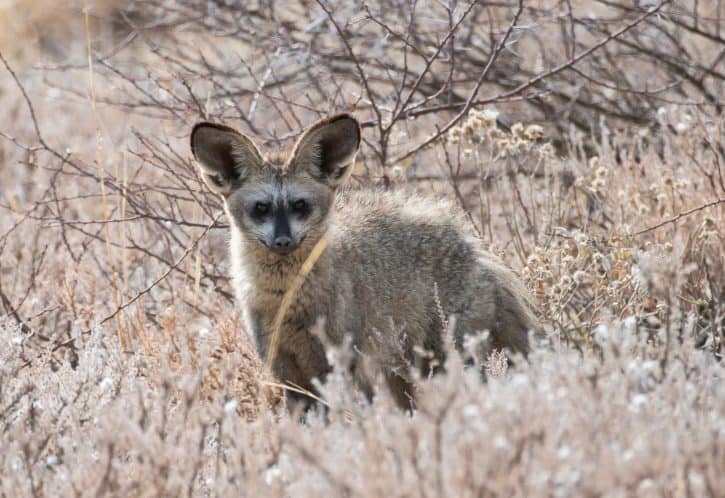
Scientific Name: Otocyon megalotis
Also called: Long-eared fox, big-eared fox, black-eared fox, Delalande’s fox, Cape fox, Motlesi
Classification: Animalia>Chordata>Mammalia>Carnivora>Canidae>Caninae>Otocyon
Habitat: Savannas and short grasslands in southern and eastern Africa: Mozambique, Namibia, Tanzania, Zambia, Zimbabwe, Botswana, Kenya, Samburu, and Kilimanjaro
Average lifespan: 13 years (captivity)
Average adult size: Just under 2 feet long (tail not included), tail 11 inches long, ears 5 inches tall, weighs 9 pounds
Diet: Carnivore (insects, mainly harvester termites; rarely they eat birds, small mammals, and reptiles)
Description: Bat-eared foxes have small bodies with disproportionally large ears. They are covered in a fluffy, sandy grey coat with a lighter tan color on their throats and bellies. Their bushy tail and bat-like ears are black-tipped, and the hair on their faces is mostly gray, often darker under the eyes and on the muzzle. Their ears are outlined in gray with gray tufts of hair around the edges. They have small teeth perfect for eating tiny bugs and a strong jaw muscle that allows them to chew quickly before bugs can escape. The front two legs are entirely black, while the hindlegs are only black at the lower part.
Behavior: Bat-eared foxes hunt in groups of two or three, and they primarily use their impeccable hearing (courtesy of those big ears) to hear bugs in the ground. Their amazing ears also function as thermoregulators, keeping them cool in the African heat. South African foxes search for food in the day or night, while the eastern foxes primarily forage at night. They are not territorial and often gather in groups of 15 foxes. These groups will play, eat, and rest together. Bat-eared foxes are expert diggers and have underground burrows containing multiple entrances, tunnels, and chambers. The burrows provide shelter for their young from the elements and predators and are also a great place to look for termites or other insects to eat.
Fun Fact: The bat-eared fox plays an important ecological role by providing natural pest control. In fact, a single fox eats up to 1.5 million termites per year!
Bearded Dragon, Central
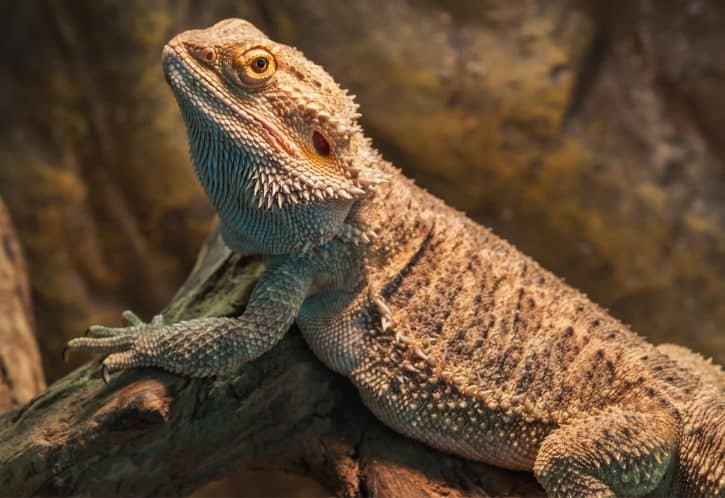
Scientific name: Pogona vitticeps
Classification: Animalia>Chordata>Reptilia>Squamata>Iguania>Agamidae>Pogona
Habitat: Rocky deserts, arid and semi-arid woodlands of central Australia
Average lifespan: Up to 8 years (wild), or up to 12 years (captivity)
Average adult size: Up to 24 inches long (including the tail), weighs about .75 pounds
Diet: Omnivore (insects, fruit, flowers, leaves, small rodents or lizards)
Description: Bearded dragons are small reptiles that are covered in specialized scales. The scales which start at their cheeks and run around the back of their heads, the edges of their backs, and on their throats are different from the rest of their body, forming prickly spikes. Their bodies vary in color from gray, brown, white and tan, to yellow, red and orange and may have subtle striping patterns. They have triangular-shaped heads, large eyes, and tiny teeth. Four short, muscular legs with five long, clawed toes allow them to bring their bodies off the ground to move about, climb and perch with ease. They have long tails that taper down in size, making up more than half of the length of their bodies.
Behavior: Bearded dragons are territorial and are typically found alone in the wild. Even in captivity, they do not do well near other bearded dragons. They are active during the day and spend their mornings and late afternoons sunning themselves for warmth. At mid-day when the sun is hottest, they move to the shade or even underground. They also enjoy perching in trees or bushes and are excellent climbers. If they feel threatened, they puff out and darken their beards, open their mouths wide and flatten their bellies against the ground to appear larger. They may also hiss at the offending party. Both sexes have beards on their throats, although males tend to “use” their beards more than females to get their message across. They communicate by bobbing their heads up and down (males do this to show dominance over another dragon) or slowly circling one of their front claws in the air (literally to say “hi” or to show submission to a larger dragon or animal). Bearded dragons are often kept as pets and do well in captivity.
Fun Fact: Bearded dragons have what is called a solar eye on their heads, which allows them to sense the level of sunlight in an area and adjust their coloration accordingly. (By adjusting their coloration from dark to light or vice versa, they can regulate their body temperature.)
Bearded Seal

Scientific name: Erignathus barbatus
Also called: Square flipper seal
Classification: Animalia>Chordata>Mammalia>Carnivora>Pinnipedia>Phocidae>Erignathus
Habitat: On or near floating ice in the arctic and sub-Arctic regions of the Atlantic, Pacific, and Arctic Oceans (depth preference less than 650 feet)
Average lifespan: 25-30 years (wild)
Average adult size: 8 feet long,weight between 450-700 pounds
Diet: Carnivore (crustaceans, mollusks, and fish like cod)
Description: Bearded seals have large rectangular body shapes, disproportionally small, earless heads and square-shaped fore flippers with long black claws. Their bodies are a muddy-gray color that is lighter on their bellies. Some seals have reddish-brown coloration on their heads and necks, and random white spots on their backs. Thick skin covers even thicker layers of body fat, comprising up to 40% of their total body weight. This fat keeps them warm in the icy waters, and therefore, it’s no surprise that their weight is highest during the winter months. On their faces, they have close-set eyes, a wide muzzle and long whiskers running down from their snouts, which is how they got their name.
Behavior: Bearded seals prefer solitude even when there are other seals nearby unless it is breeding season of course. During spring, males produce vocalizations either to attract a mate or to proclaim dominance in the area; it is not known for sure which. They have been observed sleeping vertically in the water with their faces resting on the ice but are more commonly seen with their bodies on the ice and faces hanging off the edge towards the water. This position allows them to quickly escape into the water if a predator (such as a killer whale or polar bear) shows up. They hunt for their prey on the ocean floor. When coming up to the surface for air, if there is not already a break in the ice, they use their claws to make holes in areas of thinner ice.
Fun Fact: Bearded seals have long, sensitive, white whiskers that curl up when dry and are useful in locating food on the ocean floor.
Beaver, North American
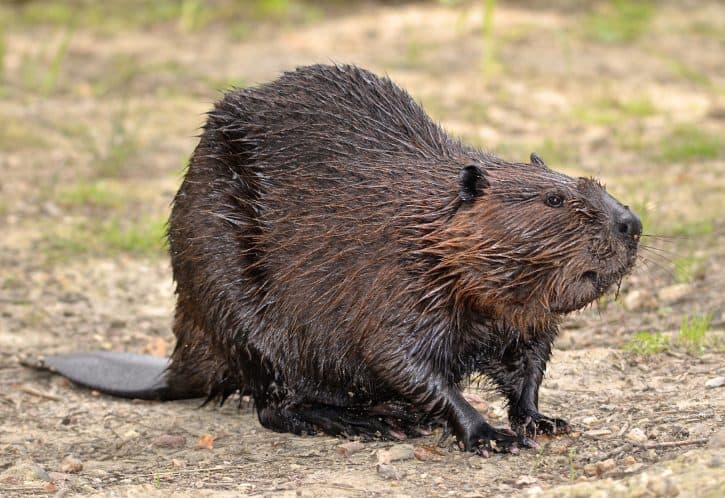
Scientific name: Castor canadensis
Also called: Beaver, American beaver, Canadian beaver
Classification: Animalia>Chordata>Mammalia>Rodentia>Castoridae>Castor
Habitat: Rivers, ponds, streams, and lakes throughout North America (Canada, the United States, and Mexico)
Average lifespan: 24 years
Average adult size: 2.5-foot-long body, 15 inches-long tail, weighs 35-60 pounds (males slightly larger than females)
Diet: Herbivore (leaves, roots, shoots, bark, aquatic plants like water lilies)
Description: Beavers are the largest rodents in North America and rival the European Beaver for the title of second-largest rodents in the world (South America’s capybara is the largest worldwide.) Their plump bodies are covered in two coats of brown fur ranging in color from pale to nearly black. The longer, coarser-haired topcoat becomes waterproof once they cover it with self-made oil, while the shorter, softer coat underneath is used for insulation. Beavers have large heads with small eyes, rounded ears, and huge incisor teeth, used for chewing wood. Their large hind feet are webbed to allow them to swim with ease, while their smaller front feet are not webbed but clawed, allowing them to pick items up. They are most known for their long, flat, textured tails which are shaped like an oar. These unique tails allow them to navigate through the water (operating like a rudder while also propelling them) or it can serve as a fat reserve, providing energy when resources are scarce. Additionally, they use their tails to communicate that a predator is nearby by slapping the water, producing a loud sound and splash to warn fellow beavers.
Behavior: Beavers are mainly active at night and spend most of their time in the water to avoid predators. They are skilled swimmers and can stay underwater for up to 15 minutes at a time. When submerged underwater, they can seal their nostrils and ears and see clearly by using their transparent eyelids. Beavers are famous for building strong dams out of large branches, fallen trees, mud, rocks, and twigs which extend across rivers or streams for the purpose of cutting off the flow of swift-moving water. By stopping the flow, beavers create a deep pool of slow-moving water that won’t freeze solid in the winter, and in which to build their homes, called lodges. They construct their lodges using mud, twigs, branches, and rocks.
Fun Fact: The beaver is the official animal of Canada and is portrayed on Canadian currency and vintage postage stamps. It is also the state animal of both Oregon and New York in the United States.
Beluga Whale
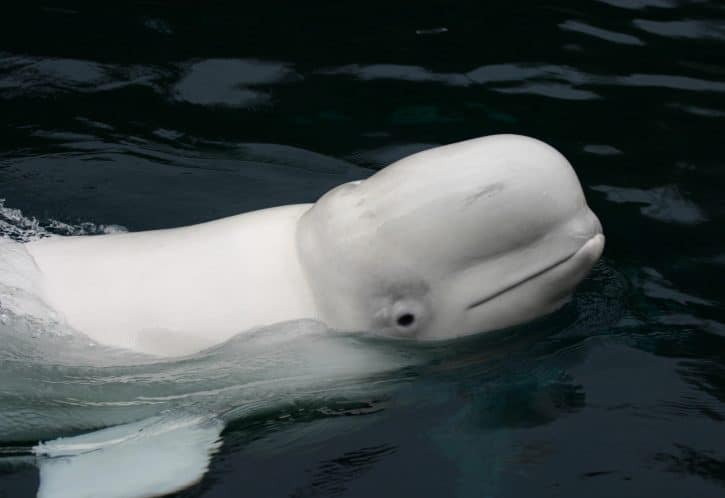
Scientific name: Delphinapterus leucas
Also called: White whale, sea canary, melon head
Classification: Animalia>Chordata>Mammalia>Artiodactyla>Cetacea>Monodontidae>Delphinapterus
Habitat: Primarily the Arctic Ocean, and open water surrounding North America, Russia, and Greenland
Average lifespan: 70-80 years based on 2006 study using radiocarbon dating
Average adult size: 15 feet long (males), 12 feet long (females), 3,000 pounds (males), 2,000 pounds (females)
Diet: Carnivore (mainly fish, and small invertebrates)
Description: Beluga whales are the only marine mammals that are white, making them easily recognizable and unique. Among the smallest of all whales, they have smooth, stocky bodies that lack a dorsal fin, and disproportionally small, rounded fins resembling oars. They have an unusually shaped head with a broad, bulging forehead containing what is called a melon, used in echolocation. Up to half of their total body weight consists of fat, which is found everywhere except the head, and can be up to six inches thick. This fat keeps the whales warm in frigid waters and acts as an energy reserve. Beluga whales are unique among cetaceans because they seasonally shed their skin and have been observed rubbing against gravel at the bottom of riverbeds to expedite the molting process.
Behavior: Beluga whales are highly social and are often found in groups called pods, consisting of about ten whales. They are unique among other whales in that they can swim backward and can turn their heads up, down, and side to side, due to their vertebrae not being fused together. The large melon on the beluga whale’s head is used to communicate and has been observed changing shape during vocalization. They make a variety of sounds, including clicks, high-pitched whistles, mews, chirps, and bleats. Even though they are toothed whales, they do not chew. Instead, they use suction to draw their prey into their mouths and then swallow it whole.
Fun Fact: The beluga whale is the only member of their genus Delphinapterus, which means “dolphin without a fin” in Greek.
Bengal Tiger

Scientific name: Panthera tigris tigris
Also called:Royal Bengal tiger, Indian tiger
Classification: Animalia>Chordata>Mammalia>Carnivora>Feliformia>Felidae>Pantherinae>Panthera>Panthera tigris
Habitat: Mangrove swamps, dense forests and tropical jungles in India, Nepal, Bangladesh, and Bhutan
Average lifespan: 9 years (wild)
Average adult size: 6.5 feet long (male body), 5 feet long (female body), 3 foot-long tail, 3.25 feet tall (shoulder), weight 480 pounds (males) or 280 pounds (females)
Diet: Carnivore (prefers large mammals like deer or bison and medium-sized mammals like wild boar, but will hunt small mammals too if larger prey is scarce)
Description: One of the largest wild cat species in the world, Bengal tigers are covered in fur ranging in color from yellow to light orange. Dark brown, gray, or black stripes run vertically down from their backbone all over their body, except for the tail which is ringed. These trademark stripes are so unique that no two tigers have the same patterns. The fur on the underside of their bodies, from their throats all the way back to their tails, is a white or cream color. Their faces are also striped with white spots of hair around their eyes, cheeks, and muzzles, and longer, tufted white hair, running like a beard up towards their ears. Completing their faces are rounded ears, piercing yellow-green eyes, pink heart-shaped noses, and long, white whiskers. They also possess the longest canine teeth of all cats, measuring up to 4 inches long, and thick, retractable claws on each paw.
Behavior: Male Bengal tigers are highly territorial, and mark their range with their scent, warning intruders to turn back. Their vast territories intentionally overlap with the home ranges of several female tigers, so they may claim them as mates. They have been found to stay close to water, to drink and cool off but also because it will be a popular place to find thirsty prey. Bengal tigers rest for much of the day and begin hunting around dusk or dawn, often traveling for miles. When hunting, they approach their prey quietly and without detection (this is called stalking) either from the side or behind, patiently waiting until the animal’s guard is down. Using their stripes to blend in with their environment, once they are as close as they can get to their prey, they chase and leap at it with their sharp claws or go for its throat.
Fun Fact: While most Bengal tigers are orange, recessive pigmentation genes in this species can produce white tigers. These rare animals are nearly entirely white with black or gray stripes and blue eyes.
Betta
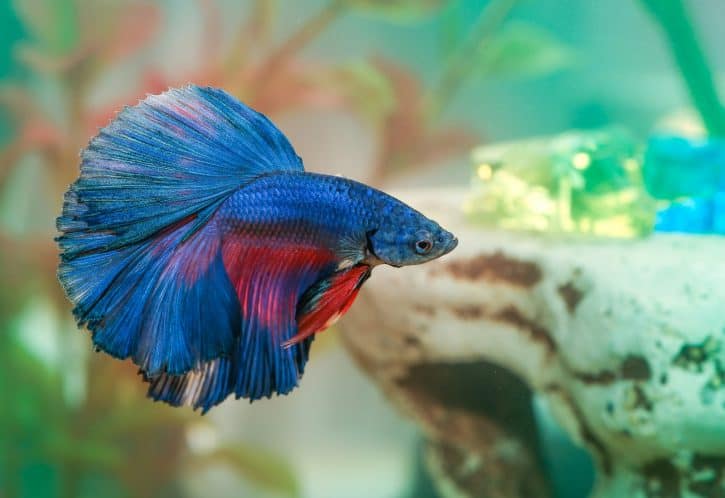
Scientific name: Betta splendens
Also called: Siamese fighting fish, plakat
Classification: Animalia>Chordata>Actinopterygii>Anabantiformes>Osphronemidae>Betta
Habitat: Shallow standing waters, floodplains, canals, and rice paddies of the Mekong basin in Thailand, Laos, Cambodia, and Vietnam (the highest concentration in the Chao Phraya river in Thailand)
Average lifespan: Up to 20 years (wild), 3 years (captivity)
Average adult size: 2.5 inches long
Diet: Carnivore (bloodworms, zooplankton, crickets, flies, grasshoppers)
Description: Bettas are small, typically brightly colored fish. On their heads, they have two large eyes and a small, grumpy-looking mouth with tiny teeth. Their bodies are covered in tiny scales, and they come in a wide variety of solid colors or dramatic color combinations, and a wide variety of types of tails. Males tend to be more colorful than females and have long, flowy fins while the fins of females are much shorter.Those big, beautiful fins are for show versus function, and slow males down considerably from their shorter-tailed wild counterparts. Since bettas are a highly popular fish in the pet trade, many people think that they are always brilliantly colored fish. However, in the wild, they are dull colors like brownish green in order to blend in with their habitats. They have been specifically bred to be colorful and ornate to catch the eye of someone looking for a new pet or a fighter.
Behavior: Bettas are highly territorial and aggressive, particularly the males, which is why they are referred to as fighting fish. They have even been observed trying to compete with their own reflection! When they prepare to fight, they puff out their gills to appear bigger than they are and flare their small beards (just like their fellow B-animal, the bearded dragon). Pale bars appear horizontally on their scales when they are stressed, or vertically when they are aggressive or ready to mate. When in captivity, males must be kept separate from other bettas to avoid a fight. They can be kept in the same aquarium as docile fish though, and female bettas can be kept together safely, provided they are less aggressive females.
Fun Fact: Did you know that a betta can jump right out of a fishbowl? It’s true! Luckily, they are equipped so they can breathe air for a short period of time, but this is something pet owners need to watch out for.
Bettong, Tasmanian
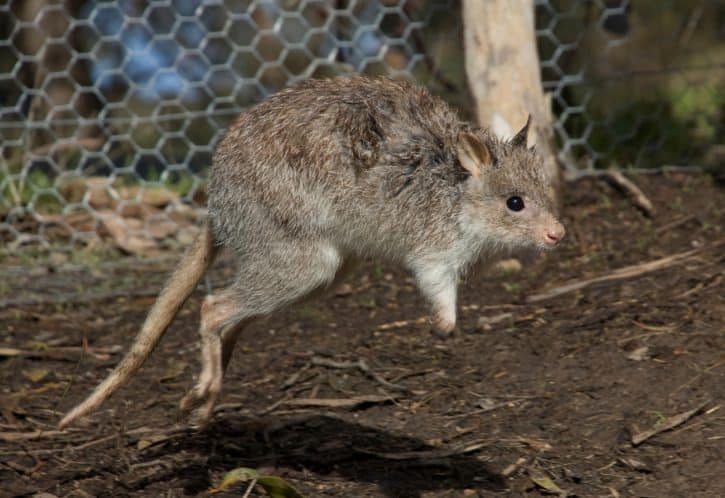
Scientific name: Bettongia gaimardi cuniculus
Also called: Balbo, southern bettong, eastern bettong
Classification: Animalia>Chordata>Mammalia>Marsupialia>Diprotodontia>Potoroidae>Bettongia
Habitat: Open eucalyptus forests, arid and semi-arid regions, grassy woodlands in eastern Tasmania (Australia)
Average lifespan: 3-6 years (wild)
Average adult size: Just over 2 feet long (including 1-foot-long-tail), weighs 4.5 pounds
Diet: Omnivore (primarily fungi, then seeds, roots, tubers, insects)
Description: Bettongs are small marsupials that are covered in gray-brown flecked hair with lighter hair on their bellies. Their heads are triangular with big black eyes, a wide, black nose, pink muzzle and pink, rounded ears. Their thick tails are as long as the rest of their body and get darker in color from base to tip. Bettongs have a pouch on their abdomens, like kangaroos, which they use to carry their young for about 100 days after birth. Their front paws are short with long, curved claws that they use to pick up and hold their food while their hind legs are strong with long, flat feet like a kangaroo.
Behavior: Bettongs are nocturnal and sleep during the day in nests. They build multiple nests by carrying leaves, branches and other nesting material wrapped in their prehensile tail (a tail that can grab, like an extra hand). They also use their muscular tails for balance when standing upright to bring food to their mouths. Bettongs don’t stay for more than a few days in any one nest and are always on the move. They hop around when they need to move quickly to outrun a predator but will move slowly on all fours when foraging. This species originally lived in mainland Australia up until the 1920s, when the introduction of the red fox to Australia caused the eastern bettong to go extinct. The only remaining members of the species can be found in Tasmania and are considered near threatened.
Fun Fact: Tasmanian bettongs go on quite a journey to find food and will travel nearly a mile between their nesting and feeding sites.
Big Brown Bat

Scientific name: Eptesicus fuscus
Classification: Animalia>Chordata>Mammalia>Chiroptera>Vespertilionidae>Eptesicus
Habitat: Widespread throughout North and Central America, the Caribbean and the northern-most areas of South America (from Alaska and southern Canada down to Colombia and Venezuela)
Average lifespan: Up to 20 years (wild) but most die during their first winter hibernation due to lack of stored fat. Males generally live longer than females.
Average adult size: 4.7 inches long, 13-inch wingspan, weight 0.8 ounces (females are slightly larger than males)
Diet: Carnivore/insectivore that only eats insects (they prefer beetles, then flies, wasps, moths, dragonflies, flying ants, lacewings)
Description: Big brown bats are relatively large bats, with rounded bodies covered in bushy brown fur ranging in color from copper to dark brown, and lighter on the belly. Their faces are significantly less hairy and black, including two large, rounded ears on the top of the head, large eyes, and a wide snout. They have two black, hairless wings that are thin and leathery, each of which has a thumb-like digit on the top. When they are not using their wings, their front limbs look like long arms that fold down tight and hinge at the elbow. Their tail is less than half their body length and is attached to a membrane which looks just like their wings. Their back legs also connect to this membrane to aid in flying, and their back feet are clawed.
Behavior: Big brown bats roost in dark crevices during the day and come out to hunt for bugs at night. Their eyesight isn’t so great, so instead of sight, they use echolocation to locate prey and avoid crashing while flying. When it’s time to rest, they can be seen hanging upside down with their legs clutching onto something above them. They hibernate through the winter, typically in caves or mines, anywhere with a stable temperature, and in a different location than their summer homes. Big brown bats are highly adaptive to their environment and can be found in both natural and human-made structures, from tree cavities to storm drains, even utilizing lamp posts as an easy hunting ground.
Fun Fact: Among the fastest bats in the world at speeds of up to 40 mph, big brown bats are versatile flyers, able to change direction quickly while using echolocation. Talk about multitasking!
Bighorn Sheep
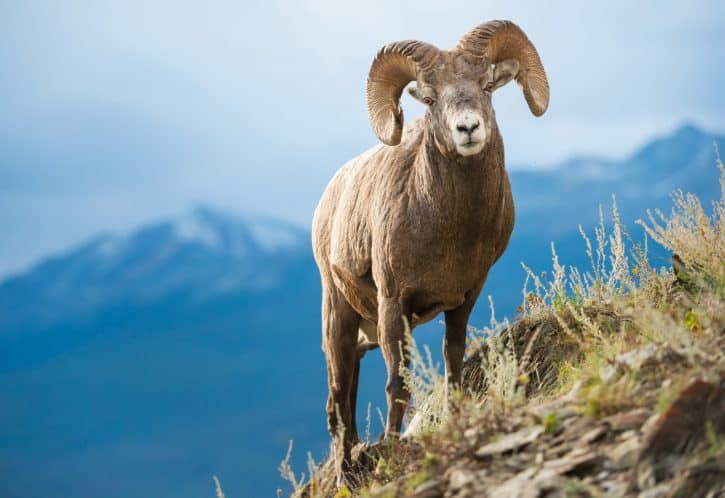
Scientific name: Ovis canadensis
Classification: Animalia>Chordata>Mammalia>Artiodactyla>Bovidae>Caprinae>Ovis
Habitat: Deserts, mountain ranges, and grasslands; from southwestern Canada, through the eastern part of the United States, down to the Mexican peninsula and northwestern coast of mainland Mexico
Average lifespan: 10-15 years (wild)
Average adult size: Males: 38 inches tall (shoulder), 5.5 feet long, up to 30 pounds (horns), weight 220 pounds (horns plus body). Females: 32 inches tall (shoulder), 4.5 feet long, weight 138 pounds
Diet: Herbivore (summer: grass and shrubs, winter: woody plants like sage and willow, desert: brushy plants like cactus and holly)
Description: Bighorn sheep got their name from the enormous, curving horns that adult males have on their heads. These amazing horns can weigh the same amount as the rest of their skeleton and are made of bone covered in keratin. The anatomy of their heads and skulls is tailored to their ramming tendencies, such that ramming is not harmful to them. Females also have horns, although they are much smaller and less curved. The bodies of both sexes are covered in light brown, gray, or dark brown fur, with white accents on their rumps, their muzzles, and the insides of their legs. Females tend to be lighter in color than males. Their hooves are split and rough on the bottom, which allows them to grip onto steep mountain ledges.
Behavior: Bighorn sheep graze throughout the day and are equally active in the day and night. Grass alone does not satisfy all their nutritional needs; they need minerals found in salt, so when foraging, they search for natural salt licks. While females eat and continue walking, males often rest after eating, which aids in their digestion. Females form herds of about ten members with their young, while a herd of only males will typically not have more than five members. Once winter comes, these herds can grow up to 100 members strong. Male Bighorn sheep are very aggressive and will face off with a rival (prior to mating season) by rising onto their hind legs and ramming into each other with their horns, at speeds up to 20 mph. This battle is fought to gain access to a new territory or to defend an existing one, along with the perks of being able to mate with the females in the territory. While it is not a battle to the death, the two sheep can battle for hours, producing a crashing sound that can be heard over a mile away. Eventually, one sheep gives up and walks away empty-handed. Bighorn sheep have excellent vision and agility, both of which aid in keeping them safe from predators. The mountain-dwelling sheep are exceptionally nimble when climbing precarious mountain cliffs to outrun a predator.
Fun Fact: Rocky Mountain Bighorn sheep can balance on a ledge that is only 2 inches long! Even more impressive is that this subspecies can weigh up to 500 pounds.
Binturong
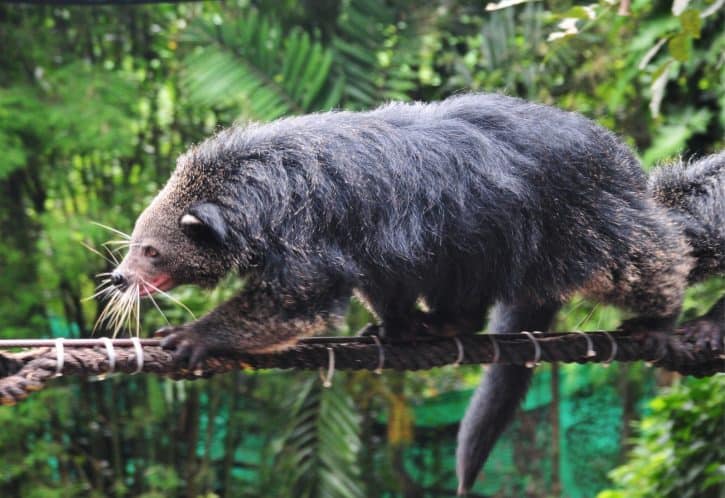
Scientific name: Arctictis binturong
Also called: Bearcat, Asian bearcat
Classification: Animalia>Chordata>Mammalia>Carnivora>Feliformia>Viverridae>Paradoxurinae>Arctictis
Habitat: Tall, dense tropical forests of southeastern Asia (India, Nepal, Bangladesh, Bhutan, Myanmar, Thailand, Malaysia, Laos, Cambodia, Vietnam, Yunnan, Sumatra, Kalimantan, Java, Palawan)
Average lifespan: Max of 25 years (captivity), or 10-15 years (wild)
Average adult size: Body 30 inches long, 26-inch long tail, weight 25-30 pounds (females are slightly bigger than males)
Diet: Omnivore (mainly fruit, but also small mammals, birds, fish, insects, eggs)
Description: Binturongs are medium-sized mammals with heavy bodies, four short legs, and a long, prehensile tail. Their tails are nearly the length of their bodies, wider at the base and tapering down until thin and curled inward at the end. Their bodies are covered in thick, black fur which can randomly be tipped in brown or gray. The hair on their faces often contains more gray, especially on their eyebrows, which makes it stand out from the rest of the body. Reddish-brown eyes, a large, black snout, and stiff, white whiskers complete their faces. Their ears are outlined in gray hair, with tufts of long black hair growing horizontally at the ends. They have five toes with strong claws on each foot.
Behavior: Binturongs are elusive creatures that are not often spotted in the wild. They live high up in the trees and don’t spend much time on the ground. Despite their somewhat heavy bodies, they are skilled climbers, using their claws, wrists that can fully rotate, and prehensile tail to climb down one tree and up another rather than leaping between the branches. They also use their tails to hold tight to tree branches while sleeping. When they walk, they walk flat-footed and are not very agile, moving about slowly. Despite their timid nature, binturongs are territorial and can be very aggressive when confronted. It is believed that the reason they are not more successful hunters is due to their slow movement, which allows prey to escape.
Fun Fact: Binturongs have a musk that smells like buttered popcorn, which they use to mark their territory. It’s a good thing they don’t live near movie theaters!
Bison, American
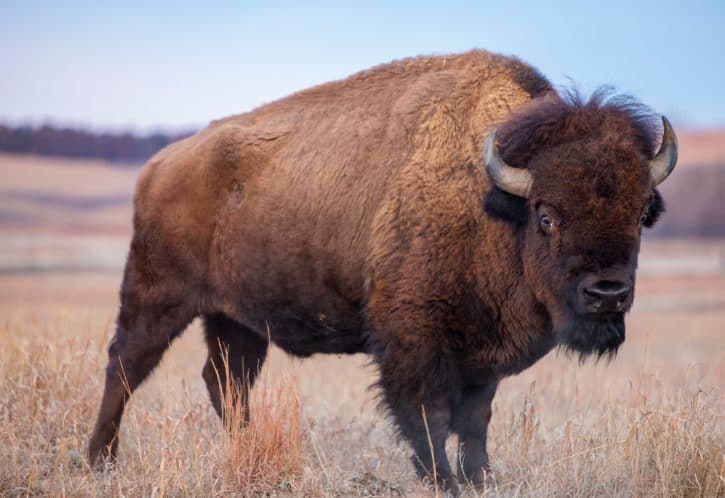
Scientific name: Bison bison
Also called: American bison, American buffalo, buffalo
Classification: Animalia>Chordata>Mammalia>Artiodactyla>Bovidae>Bovinae>Bovina>Bison
Habitat: River valleys, plains, prairies, conservation areas, nature preserves in North America
Average lifespan: 15 years (wild), 25 years (captivity)
Average adult size: 5.5 feet tall, 9 feet long, 3-foot-long tail, 2-foot-long horns, weighs up to 1,000 pounds (females) or 2,000 pounds (males)
Diet: Herbivore (grasses, herbs, shrubs, twigs)
Description: Bison are huge mammals with dark brown fur in the winter or lighter brown fur in the summer. The fur on the front part of their bodies (head, neck, chest, front legs, shoulders) is longer and woolier than the rear of their muscular bodies. They have what looks like a hump on their backs, which is supported by their skeletons. On their faces are two short, curved horns, a large, round snout, a beard, and two large eyes set on the sides of the head. American bison have four short legs with hooved feet and a thin, tufted tail.
Behavior: Bisons are social animals that form herds with up to 30 other bison. Females stay with their mothers, and other mothers with their offspring, while mature males leave their mothers to graze solo or join a bachelor herd. During the winter, herds migrate south and return north in the spring. They spend their days grazing, continuously moving, or resting in the shade or wallowing in the mud or dirt. Bison are surprisingly agile for their size and can run up to 40 mph or jump 6 feet in the air if they need to. They have poor eyesight but make up for it with their excellent hearing and sense of smell.
Fun Fact: Bisons are the largest mammals in North America and have continuously lived in the United States’ Yellowstone National Park since prehistoric times.
Black-backed Jackal
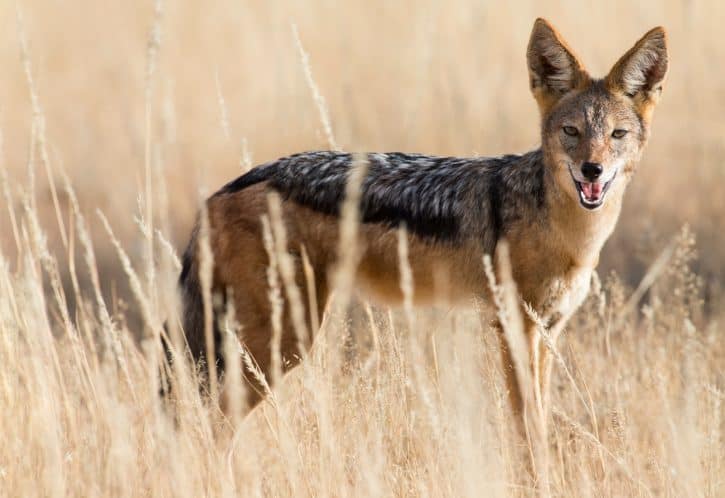
Scientific name: Canis mesomelas
Also called: Saddle-backed jackal, grey jackal, red jackal, golden jackal
Classification: Animalia>Chordata>Mammalia>Carnivora>Canidae>Canis
Habitat: Ranges from deserts to mountains to coastal areas, farmlands and savannas in southern Africa (South Africa, Botswana, Namibia, Zimbabwe) and eastern Africa (Kenya, Somalia, Djibouti, Eritrea, Ethiopia)
Average lifespan: 8 years (wild), 14 years (captivity)
Average adult size: 17 inches tall (shoulder), 40 inches long (body), 13-inches long tail, weight 16 pounds
Diet: Omnivore (insects like beetles and grasshoppers, mammals like rodents and antelopes, lizards, snakes, dead animals, fruits, berries, and the coastal jackals eat marine birds and fish)
Description: Black-backed jackals look like foxes and are covered in tan or reddish fur with darker coloration on their backs that resembles a saddle. The saddles are made up of black and silver hair that narrows from their shoulders all the way down to the ends of their tails. Their chests and underside of their bodies are white. Black-backed jackals have slender bodies, long legs, and a bushy tail. Their faces have a pointed snout, black whiskers, golden eyes, and large, hairy, triangular ears. Males are typically more brightly colored and larger than females.
Behavior: Black-backed jackals are highly territorial, with both males and females marking their territory and aggressively chasing away any intruders within their home range. They can be found in pairs, or in a family group consisting of a mated pair and their offspring. They are usually active during the day, although the jackals that live near urban areas become more nocturnal. When they rest, they find rock crevices or abandoned nests dug by other animals and have a preference for burrows with multiples exits. Black-backed jackals are highly vocal animals and can be heard yelping, whining, growling, woofing or cackling to communicate with each other, but also to scare off intruders. They have excellent hearing and sense of smell which they use to their advantage when hunting or scavenging.
Fun Fact: Fossils show that the black-backed jackal has been around for millions of years and is one of the oldest known dog species in the world.
Blackbuck
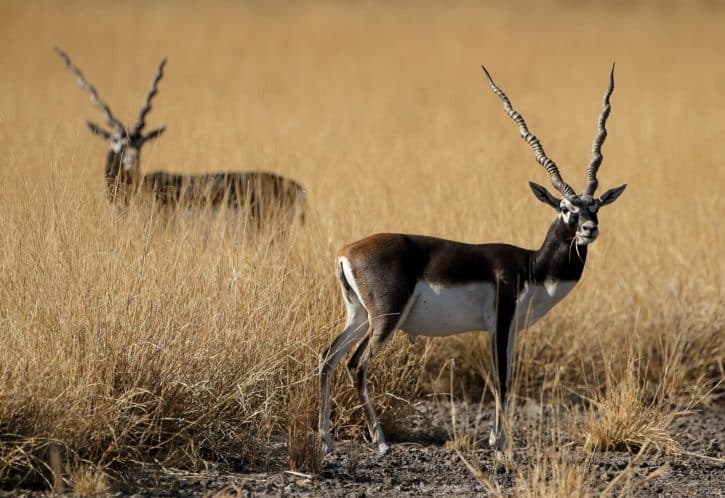
Scientific name: Antilope cervicapra
Also called: Indian antelope
Classification: Animalia>Chordata>Mammalia>Artiodactyla>Bovidae>Antilopinae>Antilope
Habitat: Grassy plains and sparse forests throughout India, Nepal, and Pakistan
Average lifespan: 15-18 years (wild)
Average adult size: 31 inches tall (shoulder), 22-inch tall horns (males), 47 inches long (head plus body), weight 84 pounds (males) or 60 pounds (females)
Diet: Herbivore (grasses, flowers, sedges, fruits off low tree branches)
Description: Blackbucks are medium-sized, short-haired antelopes and are one of the few antelopes displaying sexual dimorphism: a distinct difference in appearance between males and females of the same species. Males are larger and have dark brown to black coats on their heads, necks, backs and the top of their legs, whereas females are tan instead of brown. Males have long, spiraling, ringed horns sitting in a V shape on their heads, while females rarely have horns at all. Both sexes have slender bodies with white hair on their undersides and a circular patch of white hair around their eyes and on their muzzle, four thin legs with sharp hooves, and a short tail.
Behavior: Blackbucks are timid creatures and are usually found in one of three small herds: territorial males, females, or bachelor males. They graze throughout the day until the temperature rises, when they start grazing in the morning and early evening instead to avoid the hottest part of the day. Blackbucks rely on their eyesight to spot a threat since their hearing is average. A female is often the first to spot potential danger and alerts the rest of the herd by leaping into the air, followed by the rest of the herd. Males are only territorial during breeding season, and although two competing males may challenge each other, they do not typically fight with their sharp horns, but rather use postures and threatening gestures towards each other.
Fun Fact: Both male and female blackbucks are light brown for the first few years of life. Around two years old, the males turn a dark brown and grow their horns, allowing them to be distinguishable by their sex. Males continue to get darker in color as they age.
Black Caiman

Scientific name: Melanosuchus niger
Classification: Animalia>Chordata>Reptilia>Crocodilia>Alligatoridae>Melanosuchus
Habitat: Near South American slow-moving freshwater rivers, lakes, streams, and flooded areas near the Amazon Basin (Brazil, Bolivia, Colombia, Ecuador, French Guiana, Guyana, and Peru. The largest concentration is found in the French Guiana.)
Average lifespan: 13-20 years (captivity) or50-80 years (wild)
Average adult size: 7-16 feet long (males), 9 feet long (females), weight 700-1,000 pounds
Diet: Carnivore (fish like piranha and catfish are their primary food source, then turtles, mammals like monkeys, capybara and sloths, snakes, birds, and even other crocodilians)
Description: Black caiman is the largest species out of all of the caiman, crocodilian and alligator families. They have rough, dark scales covering their bodies that can be dark gray, brown, black, or dark olive green, with gray or brown banding on their lower jaws. Black caiman have pale yellow underbellies and white or yellow bands randomly across their mid-section, present from their youth and gradually fading as they age. Their heads are wide, and their snouts are flat, bearing powerfully strong teeth. They have four short, stocky legs with clawed feet.
Behavior: Black caimans are nocturnal hunters and usually hunt in the water, relying on their keen senses of sight and smell to guide them in the dark. In the water, they utilize their coloration to their advantage by sneaking up on land-dwelling animals drinking at the shore. Their teeth and powerful jaws are perfect for grabbing, but not so great for chewing. Therefore, the black caiman drowns its prey before eating it whole. If the prey is too big to swallow whole, it will allow the carcass to soften in the water before trying again. During the day, they often sunbathe on land to warm up, using their dark coloration to absorb heat.
Fun Fact: Black caiman are the largest predators in the Amazon Basin and are much bigger than any other caiman species. They are apex predators, meaning they are at the top of their food chain and can prey on anything within their range, including other predators.
Black-headed Bunting
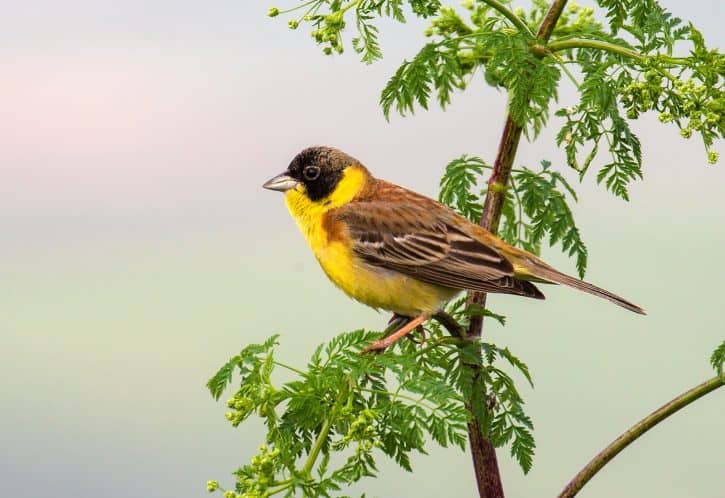
Scientific name: Emberiza melanocephala
Classification: Animalia>Chordata>Aves>Passeriformes>Emberizidae>Emberiza
Habitat: Breeding in open scrubby areas like farmlands from southeast Europe to Iran. In winter they migrate mostly to India, and some birds fly to parts of southeast Asia (Japan, China, Thailand, Laos, South Korea, Malaysia)
Average lifespan: 11 years (wild)
Average adult size: 6 inches long
Diet: Omnivore (mainly seeds, then grains, and insects for hatchlings)
Description: Black-headed buntings are large buntings with plump bodies. Adult males of this species are much brighter than their female counterparts, flaunting bright yellow feathers on their underside, black feathers called a “hood” on the tops of their heads extending over their eye area, and chestnut brown feathers on their backs and the tops of their wings. The bottom half of their wings are mainly a dark gray, with white feather outlines and chestnut accents. Their slightly forked tail feathers are long and are also dark gray. The females look like a washed-out version of the males and are pale yellow on their underside, with a pale gray hood and back. Females and males have similar coloration, on the lower part of their wings, their beaks, and feet.
Behavior: Black-headed buntings can be found in flocks and spend their days either in flight searching for feeding sites or foraging on the ground. They build their nests close to the ground in the summertime. When trying to attract a mate, males can be heard vocalizing loudly throughout the day. During their winter migration, the males flock together, as do the females, with the males generally arriving at the migrating roost sooner than the females. Once they arrive at their winter destination in India, they form communal groups with other species of birds, congregating in acacia trees.
Fun Fact: Black-headed buntings have vast ranges, up to 2 million square miles! The longest recorded migration of a single bird of this species was 4,350 miles.
Black Rhinoceros
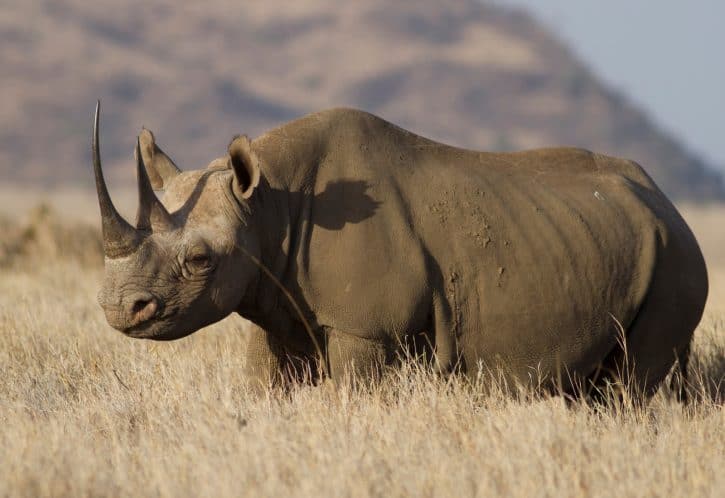
Scientific name: Diceros bicornis
Also called: Hook-lipped rhinoceros
Classification: Animalia>Chordata>Mammalia>Perissodactyla>Rhinocerotidae>Diceros
Habitat: Marshes, woodlands, bushlands in southern and eastern Africa (Cameroon, Kenya, Malawi, Namibia, South Africa, Swaziland, Tanzania, Zimbabwe; 98% of the population in South Africa, Namibia, Kenya, and Zimbabwe)
Average lifespan: 35 years (wild), up to 45 years (captivity)
Average adult size: 5 feet tall (shoulder), 11 feet long, weight 2,300 pounds
Diet: Herbivore (leaves, branches, shoots, fruit)
Description: Black rhinoceroses have huge, barrel-shaped bodies covered in a thick, hairless hide which is not black, but rather brown or gray. On the heads of both sexes are two horns set between their small eyes, the one in the front is the largest and sharpest. Some black rhinos even have three horns. They have wide, wrinkled snouts with a prehensile pointed lip (which distinguishes them from their cousin the white rhino) and rotating, cone-shaped ears tufted in black hair. Black rhinos have four strong, short legs with three-toed feet and long, thin tails that are lightly tufted with black hair at the end.
Behavior: Black rhinoceroses spend most of their days browsing for food, taking breaks to wallow in mud to keep cool or sleep during the hottest times of the day. They are solitary animals, with the only exception being a mother and her latest calf. They do become more sociable with other black rhinos at watering holes or salt licks though. Black rhinos are often territorial, and they are the most aggressive of all rhinoceroses. Two males or two females will charge at each other using their horns until one is wounded (with males, 50% of the time one is mortally wounded and with females, 30%) or gives up and leaves. In contrast, females roam in males’ territories without fear of such confrontation. They also use their horns to dig up roots or break branches when feeding. Black rhinoceroses have no natural predators. Sadly, illegal poaching by humans in pursuit of their horns has brought this species to the brink of extinction; they are critically endangered, with only four subspecies of black rhinos left in the world.
Fun Fact: Don’t let their size fool you; black rhinos are very agile for being so big and are able to quickly change directions and run at speeds of up to 34 mph. You don’t want to be on the receiving end of a rhino’s charge!
Black Vulture

Scientific name: Coragyps atratus
Also called: American black vulture
Classification: Animalia>Chordata>Aves>Accipitriformes>Cathartidae>Coragyps
Habitat: Open areas, lowlands, and forests along rivers, grasslands, swamps and pastures of the southeastern United States throughout Mexico and Central America, down to Chile and Uruguay in South America
Average lifespan: 10 years (wild)
Average adult size: 2 feet long body, 5-foot wingspan, weighs 3.5-6.5 pounds, depending on habitat
Diet: Carnivore/Scavenger (dead animal matter, eggs, newborn animals, injured animals)
Description: Black vultures are covered in glossy black feathers, except for their heads and necks which are gray and bald, and a small patch towards the end of their wings that is whitish and can only be seen during flight. Their wrinkled heads have small, brown eyes and a hooked gray beak. The wings of black vultures are relatively small, causing their flights to be less efficient than other vultures. Compared to other birds of prey, their feet are not very strong and their talons are not very sharp, requiring them to rely only on their beaks to eat.
Behavior: Black vultures are social birds of prey that roost in large flocks at night. During the day, they sun themselves early in the morning and then fly low to scavenge, using their keen eyesight to locate decaying carcasses. Their sense of smell is not as strong as other vultures, so they often follow other birds of prey to their next meal. Once they find a dead animal, they aggressively challenge any vultures other than their own kind (especially turkey vultures) to gain access, using their flock size to intimidate. Black vultures do not have vocal organs and therefore can only communicate by hisses or grunts. They seem to thrive more around civilization than they do in the wilderness, taking advantage of garbage produced by humans and roadkill hit by vehicles.
Fun Fact: Although the thought of an animal that waits around for something to die so it can eat it is morbid, black vultures play a vital role in cleaning up nature’s messes and preventing the spread of disease and bacteria present in rotting carcasses.
Black Widow, Western

Scientific name: Latrodectus hesperus
Classification: Animalia>Arthropoda>Chelicerata>Arachnida>Araneae>Araneomorphae>Theridiidae>Latrodectus
Habitat: Throughout western parts of North America, in dark, low-lying places
Average lifespan: Females: 1-3 years, Males: 1-2 months
Average adult size: Females: 1.5 inches long (legs extended), Males: .75 inches long (legs extended), weight just under 1 ounce
Diet: Carnivore (mosquitoes, flies, cockroaches, beetles, grasshoppers, caterpillars)
Description: Females have a round, shiny, black body with eight thin legs surrounding their frames, curving down in a U-shape when on solid ground. They have a distinct red or orange hourglass on the bottom of their bellies which serves as a warning to other predators as they hang upside-down in their webs. The males are not black, but brown with spots, bands or an hourglass on their backs. About half of the size of the females, males tend to have smaller bodies and longer legs.
Behavior: They spin webs out of silk they produce from their bodies and wait for prey to get caught in it. Once another insect is thoroughly stuck in a web, they quickly emerge to wrap the prey in silk. They then inject the helpless victim with potent venom (which kills it) and enzymes which convert the prey into liquid form for consumption. Black widows are solitary arachnids that have separate webs and don’t want company unless it’s time to mate. It should be noted that this species of female widow does not typically eat her mate once mating is complete.
Fun Fact: The venom of a black widow spider is 15 times more potent than rattlesnake venom. Fortunately, these tiny spiders only bite humans in self-defense and would rather be left alone to hunt bugs.
Blesbok
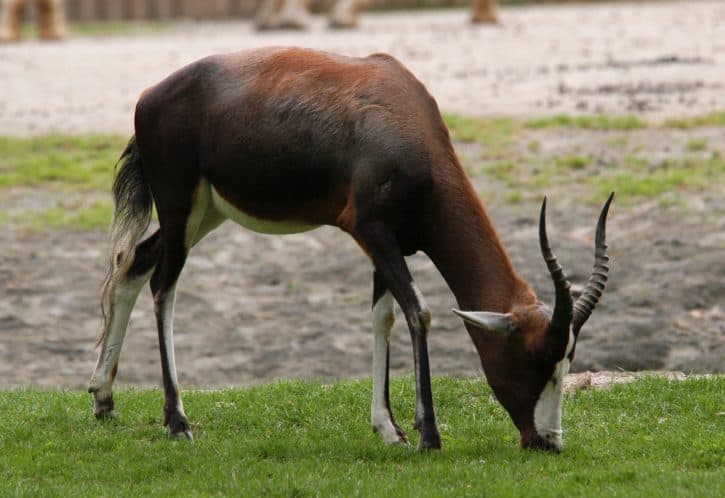
Scientific name: Damaliscus pygargus phillipsi
Also called: Blesbuck
Classification: Animalia>Chordata>Mammalia>Artiodactyla>Bovidae>Alcelaphinae>Damaliscus>Damaliscus pygargus
Habitat: Open grasslands found in national parks of South Africa and Namibia
Average lifespan: 17 years
Average adult size: 3 feet tall (shoulder), body 5 feet long, 15-inch-long tail, 15-inch-long horns, weight 150 pounds
Diet: Herbivore (short grasses)
Description: Blesbok have dark brown coats with lighter brown coloration on their throats, necks, and rumps, and appearing like a saddle on their backs. They have a rectangular white patch on their faces that runs from their muzzles up to between their eyes, and a prominent white patch of hair on their brown foreheads resembling a flame, placed between where their horns attach to their heads. Both sexes have spiraled, ringed brown horns, although the horns on a female are generally shorter and thinner than on the males. Their ears appear white from the front, are tufted with hair, pointed diagonally, and positioned next to their eyes. They have thin legs that are whitish at the bottom half and brown with white patches at the top. Their bellies and the inside of their legs and buttocks are white. Their tails are long and covered in long, wavy brown and white hair.
Behavior: Blesboks graze for much of the day and rest mid-day and at night. They are social animals and live in small herds of up to 25 antelope. These herds are loosely structured, allowing for the mingling of animals with different small groups. The adult males of the group protect the rest of the herd from predators by grunting and snorting to sound the alarm. Males are aggressive and territorial with each other primarily during mating season and will clash horns, sometimes ending in the death of one of the animals. Once mating season ends, blesbok can be seen congregating in large herds.
Fun Fact: Blesbok nod their heads when they are content or anxious, or when a male is courting a female. Talk about sending mixed signals!
Blotched Blue-tongued Skink
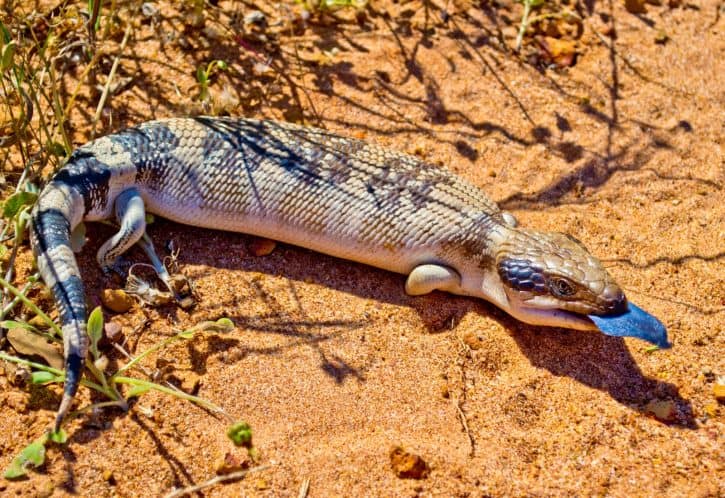
Scientific name: Tiliqua nigrolutea
Also called: Blotched blue-tongued lizard, southern blue-tongued lizard, blue tongues
Classification: Animalia>Chordata>Reptilia>Squamata>Scincidae>Tiliqua
Habitat: Woodlands, grasslands, and wet and dry forests of southeastern Australia, including Tasmania and the islands of Bass Strait
Average lifespan: Up to 30 years (captivity)
Average adult size: 1-2 feet long (including 13-inch-long tail), weight 0.75 pounds
Diet: Omnivore (insects, snails, worms, caterpillars, leaves, flowers, fruit)
Description: Blotched blue-tongued skinks are large skinks with smooth, flat scales. Their bodies are colored black or dark brown with alternating yellow, cream, orange or pink blotches running down their backs and tails. Sometimes the blotches form rings on their tails. They have large, triangular heads supported by thick necks, reptilian eyes and strong jaws able to easily crush snail shells. Their bodies are stocky, held above ground by four short legs and a thick, tapering tail. Each foot has five clawed toes on it. Males have a bigger head and stockier build than females, which are bigger in general.
Behavior: Blotched blue-tongued skinks are shy, solitary creatures that search for food on the ground or bask in the sun during the day. They are slow movers, which is why much of their prey are also slow (snails, slugs, caterpillars), making them easy targets. At night, they rest in a sheltered hole or burrow to avoid becoming prey. If a predator grabs them by the tail, they can detach their tails as a form of self-defense. The detached tail will continue moving for a short time which distracts the predator long enough for the skink to escape to safety. A new tail will grow back in its place, although it won’t look the same as the original. Additionally, they utilize camouflage for blending in with the ground, which is useful for self-defense as well as hunting.
Fun Fact: Blotched blue-tongued skinks use their bright blue tongues to scare away predators by opening their mouths wide and hissing. I bet the predators think they are aliens from another planet!
Blue-and-Yellow Macaw

Scientific name: Ara ararauna
Also called: Blue-and-gold macaw
Classification: Animalia>Chordata>Aves>Psittaciformes>Psittacidae>Ara
Habitat: South Americantropicalforests, woodlands, and savannas (Venezuela, Bolivia, Peru, Brazil, Paraguay), just barely into Central America (Panama)
Average lifespan: 30-35 years (wild), up to 60 years (captivity)
Average adult size: 32 inches long (including 2-foot-long tail), 43-inch wingspan, weight 2.5 pounds
Diet: Herbivore (seeds, fruit, nuts, leaves, flowers)
Description: Blue-and-yellow macaws are large, vividly colored parrots. They have lime green feathers at the tops of their heads, turquoise feathers starting behind their eyes and continuing down their backs, and the lower half of their wings and top of their tailfeathers are cobalt blue. Their throat has a dark patch of feathers, mainly black with touches of green, and the rest of their underside is a bright golden-yellow color, including the bottom of their tailfeathers. They have a strong, curved, black beak and white featherless faces, striped with fine black feathers around their light-yellow eyes, and gray feet with black talons.
Behavior: Blue-and-yellow macaws are social animals and flock together in the wild, in groups of 100. These groups do not have a dominant leader; instead, each bird is treated equally. They spend their days playing, bathing, and foraging for food. This species of macaw mates for life and once they find a mate, they stay close to each other with wings nearly touching during flight. To communicate, blue-and-yellow macaws produce loud screams and “flock calls,” and captive parrots are quick learners that easily learn to mimic human voices. They are highly intelligent birds, as smart as 3 or 4-year-old humans. They have strong personalities and tend to be playful, stubborn, and witty with their owners.
Fun Fact: The longest-living captive blue-and-yellow macaw was named Charlie the Curser and, according to its owner, was born in 1899, making it well over 100 years old!
Bluebottle
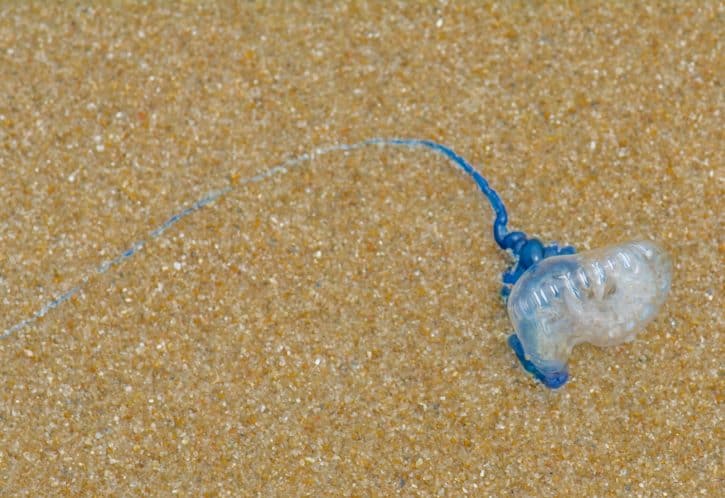
Scientific name: Physalia utriculus
Also called: Indo-Pacific man of war
Classification: Animalia>Cnidaria>Hydrozoa>Siphonophorae>Cystonectae>Physaliidae>Physalia
Habitat: At the surface of the open Indian and Pacific Oceans, particularly near Australia
Average lifespan: Unknown
Average adult size: Sail up to 4 inches long, tentacles up to 10 feet long
Diet: Carnivore (small fish and crustaceans)
Description: Instead of just one organism as many animals are, each bluebottle consists of a colony of four organisms called zooids, each performing crucial roles to ensure the survival of the species. The pneumatophore, or float, is at the top and is a nearly clear, gas-filled “sail” which is responsible for moving it around the ocean’s surface. It is primarily a bright blue color with subtle pink or green tinges at the crest and truly shaped like a bottle. Next is a single, long, retractable tentacle and shorter tentacles called the dactylozooid, which locate, sting, immobilize and reel in the prey. Once the prey has been captured, it is brought to the gastrozooids, which is how the bluebottle eats and digests. The fourth organism is the gonozooid, which aids in reproduction of the species.
Behavior: Bluebottles float around on the ocean’s surface, with the sail sitting above the surface and the tentacle and other zooids submerged under the surface. Although they can move slowly, their primary form of transportation is the wind and the waves. The crest moves via muscular contraction and functions like a rudder on a boat. Should a threat approach on the surface, they are able to deflate their sails slightly and can submerge for a brief amount of time. Bluebottles are often found in swarms in the open water which sometimes get moved onto the shore by strong winds where they become a risk to humans. A severed tentacle or dead bluebottle can retain its sting potency for hours or days afterward.
Fun Fact: Bluebottles may have met their match in the clever man-of-war fish, which is biologically resistant to their stinging cells and often lives among the bluebottle’s tentacles, using them as a sort of shield from predators.
Blue Crab

Scientific name: Callinectes sapidus
Also called: Atlantic Blue Crab, Chesapeake Blue Crab
Classification: Animalia>Arthropoda>Crustacea>Malacostraca>Decapoda>Brachyura>Portunidae>Callinectes
Habitat: On the floors of brackish coastal lagoons and estuaries in the Atlantic Ocean and Gulf of Mexico, from Nova Scotia, Canada to Argentina, South America (depth range from low tide to 120 feet)
Average lifespan: 1-3 years (wild)
Average adult size: 4-5 inches long, 7-9 inches wide, weight 1-2 pounds
Diet: Omnivore (mollusks, snails, insects, fish, shrimp, dead animal matter, aquatic plants, even smaller blue crabs if food options are low)
Description: Blue crabs are colorful crustaceans, named for the bright blue color of their legs and pinchers. Females can be identified by their red-tipped pinchers and are slightly less wide than males. Exoskeletons form hard shells that cover and protect the blue crab’s soft body. The main shell on their bodies, called the carapace, is rounded, has sharp spines on each side and ranges in color from light brown to bluish olive green, with white coloration on their undersides and the tops of their legs. Each blue crab has ten legs in total: two large pinchers in the front used for grabbing and self-defense, three pairs of legs used for walking, and two paddle-shaped hind legs that they use for both walking and swimming. Their eyes are set at the edge of the carapace, and their mouth is on the underside of their bodies.
Behavior: Blue crabs are solitary scavengers, searching the ocean floor for food. They are not picky when it comes to their eating preferences and are generalists, meaning they eat a wide variety of whatever crosses their paths. They are defensive crabs, except immediately following a molt, when their shells are softer and more vulnerable to predators (or humans that want soft-shelled crab, for that matter.) Females molt for the last time before they mate, while males will continue to molt throughout their lives, often once a year. When they wash up on land, they can only walk sideways and prefer to be in the water, especially since they are excellent swimmers.
Fun Fact: You can tell if a blue crab is male or female by which U.S. monument it has on its belly! Females have a ridge shaped like the Capitol building, while males have a thinner ridge resembling the Washington Monument.
Blue-eyed Black Lemur
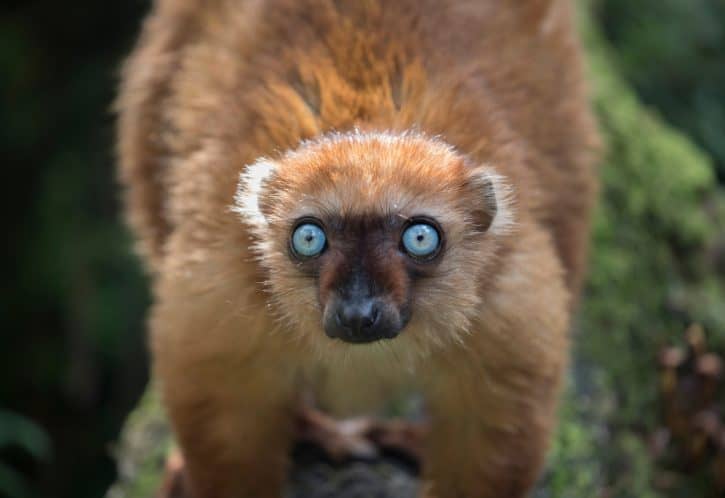
Scientific name: Eulemur flavifrons
Also called: Sclater’s lemur
Classification: Animalia>Chordata>Mammalia>Primates>Strepsirrhini>Lemuridae>Eulemur
Habitat: Subtropical moist and dry forests in the northwestern part of Madagascar, between the Andranomalaza and Maevarano Rivers
Average lifespan: 20-25 years (captivity)
Max adult size: 1.5 feet long body, tail up to 2 feet long, weighs up to 4 pounds
Diet: Omnivore (nectar, leaves, flowers, fruit, pollen, seeds, insects and sometimes birds)
Description: Blue-eyed black lemurs are considered true lemurs and are covered in fur. The males have primarily black fur which sometimes is brown at the root, while females have reddish-brown to gray coats and tan bellies. Both sexes have blue eyes which vary from bright blue to a gray-blue. They have two arms and two legs, with the arms being slightly shorter than the legs. Their tails are longer than their bodies but cannot be used to grip tree branches, as monkeys can.
Behavior: Blue-eyed black lemurs are critically endangered, and as a result, most of them live in captivity to preserve the species. Therefore, there is not much information about their behavior in the wild and most of what we know has been learned by observing them in captivity, or by observing common black lemurs in the wild. Blue-eyed black lemurs are social animals, living in large groups of up to 15 lemurs. Females are dominant, and as a result, more males than females form a group. They are primarily active during the day and spend most of their time in the tree canopy. When they venture down to the ground, they move about on all fours with their tails high in the air. When in the trees, they jump from branch to branch using their strong arms and hands. Females are highly aggressive, leave their scents to mark their territory, and have been known to display violence towards other lemurs.
Fun Fact: Blue-eyed black lemurs are the only primates (besides humans) with blue eyes. However, if they mate with a different species of lemur, the offspring will be born with orange eyes common to lemurs.
Blue-footed Booby
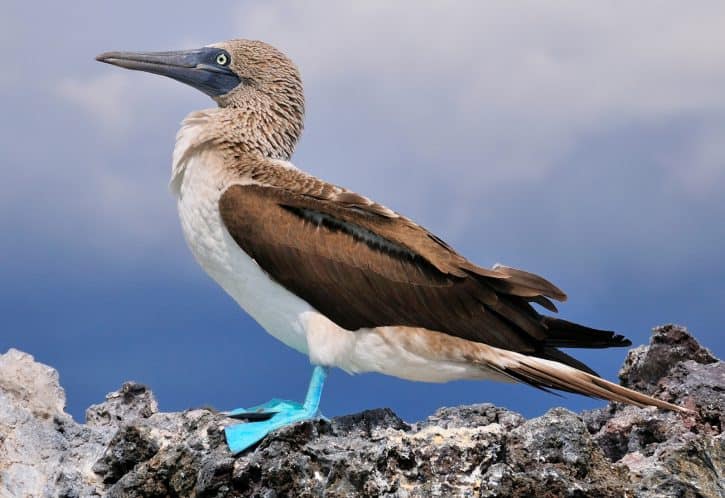
Scientific name: Sula nebouxii
Classification: Animalia>Chordata>Aves>Suliformes>Sulidae>Sula
Habitat: Tropical and subtropical areas of the eastern Pacific Ocean shoreline (from California in the U.S. down to the Galapagos Islands to Peru in South America)
Average lifespan: Up to 17 years
Average adult size: 32 inches long, five-foot-long wingspan, weight 3 pounds (females are slightly larger than males)
Diet: Carnivore/piscivore (primarily schooling fish like sardines, anchovies or mackerel, or occasionally squid)
Description: Blue-footed booby birds are medium-sized birds with dark brown feathers on their backs and wings, light brown feathers streaked with white highlights on their heads and white feathers on their bellies. Their dark brown tailfeathers are sharply pointed and are utilized during their mating dance. On their faces are bright yellow eyes set on the top sides of a tapering, blue-gray beak, with nostrils that are sealed shut to keep the water out when hunting. They are best known for their blue webbed feet, which range in color from dull to bright blue.
Behavior: Blue-footed booby birds travel and hunt in groups of about 12 birds. They sleep on land in their nests at night and hunt in the water during the day. When hunting for fish, they survey the area from the air, then dive into the water from up to 80 feet above and swim to depths of up to 80 additional feet to grab their prey, typically eating it while still underwater. They spend very little time on land, often just for nesting or while caring for their young. When a male is trying to attract a mate, it performs a theatrical dance for a nearby female and shows off his feet, while performing wing displays and moving his head up and down.
Fun Fact: Did you know that you can tell the health of a blue-footed booby simply by looking at their feet? This is because the pigments obtained from their diets are concentrated in their feet. Females wisely take foot brightness into consideration when selecting a mate.
Bluegill
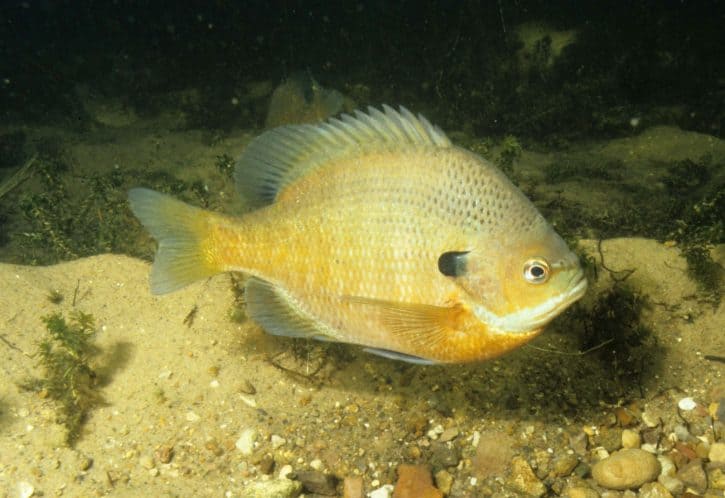
Scientific name: Lepomis macrochirus
Also called: Sunfish, bream, brim, coppernose
Classification: Animalia>Chordata>Actinopterygii>Perciformes>Centrarchidae>Lepomis
Habitat: Very deep or very shallow freshwater lakes, ponds, streams, rivers, creeks throughout North America (Quebec, Canada to northern Mexico)
Average lifespan: 5 years (wild), 8 years (captivity)
Average adult size: Up to 12 inches long, weighs up to 4.5 pounds
Diet: Omnivore (insects, crayfish, small fish and eggs, zooplankton, worms, aquatic vegetation)
Description: Bluegills are a type of sunfish that have tiny mouths and oval-shaped, flat bodies with scale coloration that varies from green to yellow and sometimes black. They got their names from the blue or purple coloration on their cheeks and gill covers. Up to 8 vertical stripes typically appear on their backs that are olive green in color. Males are brightly colored during mating season, with orange or red bellies. Bluegills have an additional black spot near their gills, on their ear flaps. Their dorsal fin is long, containing spines in front and smooth in the back, with a dark spot at the end. They have 2 pointed pectoral fins, a rounded pelvic fin that has a few spines in front, and a forked tailfin.
Behavior: Bluegills can be found in schools of up to 20, which includes different types of fish. They are most active at dawn, hunting by pulling water into their mouths and using gill rakers to trap prey there. Then they hide in aquatic vegetation (particularly submerged tree trunks or fallen branches) during the day, emerging again at dusk. At the end of the day, they seek out shallow water for the night to rest. They are agile and adaptable and can change directions quickly and easily, allowing them to escape from predators.
Fun Fact: For fishing enthusiasts, bluegills are a fan favorite due to their year-round presence, tendency to overpopulate, and willingness to bite anything they see. In fact, this species is commonly a young fisher’s first catch.
Blue-throated Bee-eater
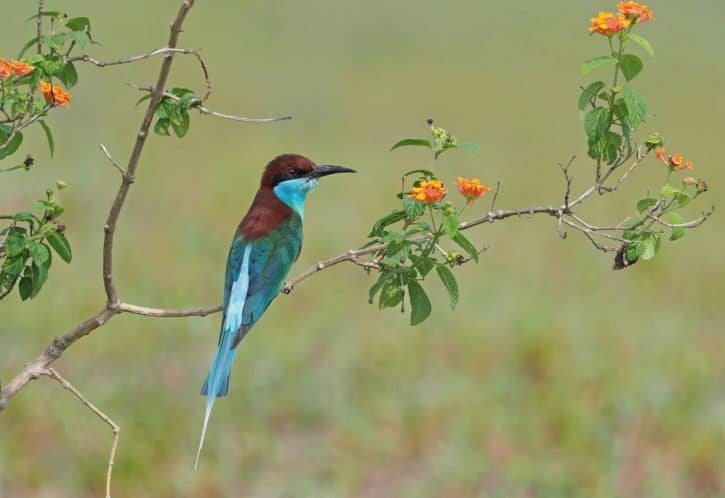
Scientific name: Merops viridis
Also called: Chestnut-headed bee-eater
Classification: Animalia>Chordata>Aves>Coraciliformes>Meropidae>Merops
Habitat: Subtropical or tropical mangrove forests, scrubs, parklands or urban areas in southern China and most of southeast Asia (Brunei, Cambodia, China, Hong Kong, Indonesia, Laos, Malaysia, the Philippines, Singapore, Taiwan, Thailand, Vietnam)
Average lifespan: 5-6 years (wild)
Average adult size: 11 inches long, including tail
Diet: Carnivore/insectivore (beetles, bees, wasps, hornets, ants, dragonflies)
Description: Blue-throated bee-eaters are brightly colored with chestnut-colored feathers on their heads and down the top of their necks to the middle of their backs, a black streak across their eyes, bright blue feathers on their throats, and primarily green feathers blending into blue or sometimes white everywhere else (bright green on their chests, light green by their legs, with emerald green wings). When in flight, they have distinctly triangular-shaped wings with sharp edges. Their lower backs and tailfeathers are light blue like their throats, and their tail has two thin white feathers called streamers. The streamers are much longer than the other tail feathers and stick out in the center. On their faces are round, red eyes and a black, slightly curved, sharp beak.
Behavior: Blue-throated bee-eaters nest in colonies that contain up to 20 pairs of birds on average but can grow to 200 birds in favorable conditions. They make their nests in the ground, often sand if it has good drainage, and prefer shallow dunes or level ground such as found at the beach, on golf courses, or even front lawns. Blue-throated bee-eaters regularly bathe in water and constantly preen their feathers. They bathe in sunlight as well, spreading their wings and opening their mouths. When they eat a bee or wasp, they hold it in their mouth and hit it against the ground or squeeze it with their beaks to remove the stinger or venom first. Their flight patterns are jerky with 2-3 rapid beats of the wing followed by a glide. They have huge ranges and go to Singapore to breed, then migrate to Indonesia starting in September.
Fun Fact: Bee-eaters are some of the most beautifully colored birds in the world! I can’t help but wonder if their bright colors aid in drawing bees closer to them, just as brightly colored flowers do?
Blue Whale

Scientific name: Balaenoptera musculus
Classification: Animalia>Chordata>Mammalia>Artiodactyla>Cetacean>Balaenopteridae>Balaenoptera
Habitat: All the world’s open oceans, except the majority of the Arctic Ocean
Average lifespan: Estimated at 80-90 years
Average adult size: Up to 105 feet long, max weight of 200 tons (females are longer than males by up to 32 feet)
Diet: Carnivore/zooplanktonivore (zooplankton, and small crustaceans, fish or squid that get randomly pulled into their mouths while they are trying to eat plankton)
Description: Blue whales have incredibly long, slender bodies that appear bluer in the water than they are when beached. Their bodies are a grayish blue color with random light gray splotches, except for their light gray, grooved throats that extend from their chins to their bellybuttons. Microorganisms often cling to the bottoms of their bodies and give it a yellowish hue, earning them a nickname of “sulfur-bottom.” Instead of teeth, they have nearly 400 fringed plates called baleen attached to their upper jaw. Blue whales have a very small dorsal fin on their backs compared to their size, measuring only 11 inches tall. In contrast, their two large flippers can measure up to 13 feet each, and they have a large tailfin called a fluke. Two blowholes sit on the tops of their flat, U-shaped heads which shoot water and air up to 30 feet high when they surface to breathe.
Behavior: Blue whales are primarily solitary mammals, although they can be found in groups of up to three other whales. Groups of up to 50 are observed at prime feeding sites. To feed, they dive to depths of over 300 feet for up to 10 minutes at a time, taking large quantities of zooplankton-filled water into their mouths. Their baleen plates are then used to lock any prey in while they filter the water out. They prefer swimming in deep ocean waters versus coastal areas and migrate towards the north or south pole during the summer to feed before migrating back towards the equator in the winter. They produce a low-frequency song that can be heard over thousands of miles underwater and is louder than a jet engine. Scientists believe this song is used to communicate with other whales across great distances.
Fun Fact: Blue whales are the largest animals to have ever lived on Earth, even bigger than the dinosaurs. In fact, blue whales weigh about twice as much as a large dinosaur. It’s amazing that these massive animals primarily eat krill, which measures less than three inches long!
Boa Constrictor
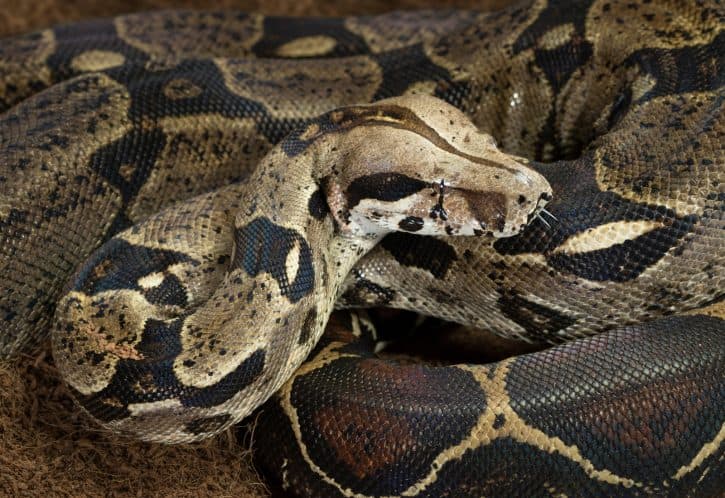
Scientific name: Boa constrictor
Also called: Red-tailed boa, common boa
Classification: Animalia>Chordata>Reptilia>Squamata>Serpentes>Boidae>Boa
Habitat: Deserts, savannas, wet tropical forests of Mexico, Central, and South America, as well as in the Caribbean islands
Average lifespan: 20-30 years (wild)
Average adult size: 10 feet long, weight 60 pounds (females are larger than males)
Diet: Carnivore (small to medium-sized birds, small rodents, bats, amphibians, large lizards)
Description: Boa constrictors are heavy-bodied, large snakes. Their limbless bodies are typically tan, yellow, red or green, with contrasting patterns ranging from circles, jagged lines, ovals and diamonds, and lighter underbellies. Boa constrictors have narrow, triangular heads with two wide bands running from their eyes to the end of their heads, and a thinner line running from between their nostrils to the end of their heads, before blending in with the rest of their bodies.
Behavior: Boa constrictors are solitary, nocturnal snakes. They are excellent swimmers and easily climb trees; however, they prefer to stay on dry land, making their homes in abandoned animal burrows and hollow logs. They hunt using their forked tongues to taste the air and their keen eyesight to locate prey, typically utilizing an ambush approach. Like their fellow nonvenomous cousins, the ball python and Burmese python, boa constrictors grab their prey with their mouths, wrap their bodies around and squeeze the animal until it dies, then eat it whole using highly flexible jaws.
Fun Fact: Boa constrictors are one of the few species of animal that has the same common and binomial scientific name. Tyrannosaurus Rex is another such example.
Boat-billed Heron

Scientific name: Cochlearius cochlearius
Also called: Boatbill
Classification: Animalia>Chordata>Aves>Pelecaniformes>Ardeidae>Cochlearius
Habitat: Mangrove swamps from Mexico down through Central America as far into South America as Peru and Brazil
Average lifespan: 8 years
Average adult size: 21 inches long, 2.5-foot wingspan, weight 1.3 pounds (males are slightly larger than females)
Diet: Carnivore (crustaceans, small fish, insects, amphibians, eggs, small mammals)
Description: Boat-billed herons are medium-sized, stocky birds which have pale blue-gray feathers on their backs and wings, black hoods on their heads, black feathers on their upper backs and down the sides of their bodies, and a light brown coloration on the rest of their bodies. A small patch of whitish feathers runs in a line across their foreheads and is present on their cheeks and throats. Boat-billed herons have a broad bill shaped like (you guessed it!) a boat, which is perfect for scooping up prey. They have large brown eyes and relatively short necks and legs for a heron.
Behavior: Boat-billed herons are solitary, nocturnal hunters, except during breeding season when they hunt during the day. They typically spend their days roosting and preening under cover of vegetation and come out to hunt or forage at dusk. When they hunt, they often stand on low-hanging tree branches or roots and dip their opened beaks into the water to scoop up prey. Another form of hunting is standing or slowing walking in the water and lunging at fish at the perfect moment. Bird experts think that they use their sense of touch to hunt in murky shallow water, but they also have keen eyesight.
Fun Fact: Boat-billed herons do not molt, and their downy feathers continuously grow throughout their lives. The ends break off in the form of powder which the bird uses to waterproof its other feathers.
Bobcat
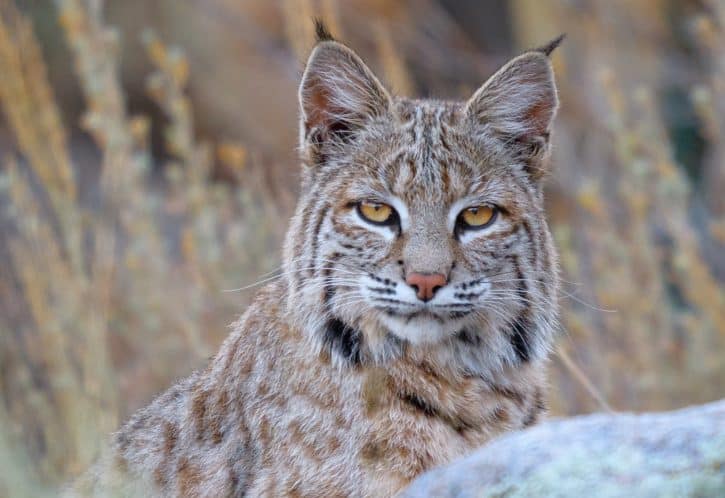
Scientific name: Lynx rufus
Classification: Animalia>Chordata>Mammalia>Carnivora>Feliformia>Felidae>Felinae>Lynx
Habitat: Woodlands, swamps, mountainous regions, and desert lands from southern Canada throughout the United States to southern Mexico
Average lifespan: 10 years (wild), 20-25 years (captivity)
Average adult size: Body 32 inches long, tail 5.5 inches long, 18 inches tall (shoulder), weight 21 pounds (males), or 15 pounds (females)
Diet: Carnivore (rabbits, hares, small rodents like squirrels or mice, insects, fish, birds, snakes, lizards, poultry, deer)
Description: Bobcats are medium-sized wild cats, although they are the smallest of their genus. They are covered in thick fur that is gray, tan or brown, sometimes with reddish tints, and always with subtle black or brown streaks or bars on their fur. Their underside is whiter, and they have white outlines around their eyes and white hair on their muzzles. On their faces are long, white whiskers, muttonchop-like beards, a pink nose, and two yellow eyes with black pupils. Their trademark long tufts of black hair come to a point and peek out behind their otherwise white ears. Another unique trait to bobcats is their short, stubby tails which sometimes are not long enough to be noticeable.
Behavior: Bobcats are solitary, territorial cats, with females generally acting more aggressively towards intruders than males. They primarily communicate through scent when marking territories, or yowling sounds during breeding season, which is the only time males and females interact. Bobcats are most active at dusk and dawn and sleep in hidden dens, hollowed-out trees, thickets or rocky crevices. They hunt by stalking their prey, chasing it and pouncing on it, using their excellent sense of sight and hearing to their advantage. They are excellent climbers and can leap up to 10 feet at a time, even catching low-flying birds in flight.
Fun Fact: Did you know? Bobcats can run up to 30 mph and step with their back feet in the same spot their front feet were, to reduce the noise made in chase.
Boll Weevil

Scientific name: Anthonomus grandis
Classification: Animalia>Arthropoda>Insecta>Coleoptera>Curculionidae>Curculioninae>Anthonomini>Anthonomus
Habitat: Developing cotton bolls in tropical and subtropical climates (southern United States, Mexico, Central America, Cuba)
Average lifespan: About 3 weeks
Average adult size: 0.25 inch long
Diet: Herbivore (cotton buds and flowers)
Description: Boll weevils are beetles that are reddish-brown, gray, or black and covered with short hair. Their noses are nearly half their total body length and are elongated (almost like the trunk of an elephant) with two hinged antennae extending out from each side. They have two spurs on the upper part of each of their front legs and six legs total.
Behavior: Boll weevils overwinter in trash and leaf litter and emerge in spring to mate. Then, the females lay up to 200 eggs inside separate cotton buds or ripening bolls (flowers). Roughly five days later the eggs hatch and they spend up to 2 weeks feeding on cotton before developing into pupae. They pupate for about a week; then they eat their way out of the cotton plant as adults. About a week later, the process starts again. Boll weevils produce 5-7 generations each year and are the most destructive pests in the United States, costing U.S. cotton producers roughly $300 million per year in destroyed crops. As of 2013, Texas is the only U.S. state still struggling with boll weevil infestations, following the efforts put forth by the U.S. Department of Agriculture.
Fun Fact: In the state of Alabama in the United States is a monument dedicated to the boll weevil. Citizens were grateful to the boll weevil for forcing them to switch gears and invest in mixed farming and manufacturing, where they previously invested in cotton only.
Bongo
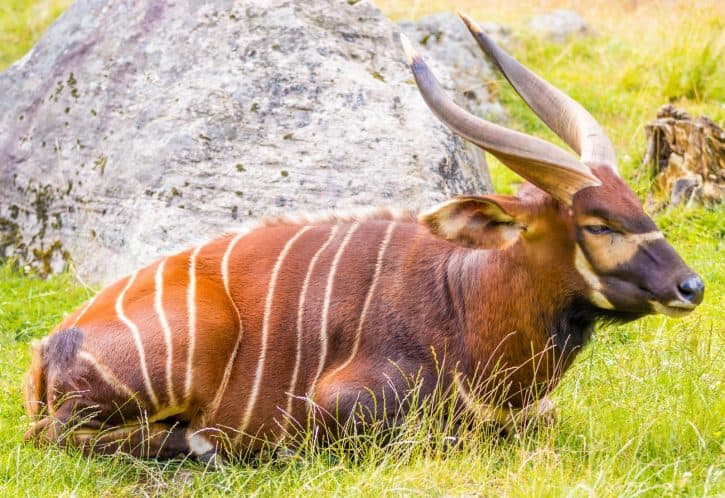
Scientific name: Tragelaphus eurycerus
Classification: Animalia>Chordata>Mammalia>Artiodactyla>Bovidae>Bovinae>Tragelaphus
Habitat: Lowland forests, thickets and tropical jungles in sub-Saharan Africa (Zaire, West Africa to southern Sudan, also in Kenya to the Congo)
Average lifespan: Up to 19 years (captivity)
Average adult size: 4 feet tall (shoulder), body 8.5 feet long, tail 22 inches long, weight 420 pounds (females) or 680 pounds (males)
Diet: Herbivore (leaves, roots, flowers, grasses, fruits, bark, and minerals from salt licks)
Description: Bongos are the largest of all forest-dwelling antelopes and have short coats, typically reddish-brown with 10-15 thin white stripes running vertically down each side of their bodies. A short mane runs down their spines and matches the coloring of the stripes as they intersect. Bongos have a horizontal crescent on their chests, and white stripes between their eyes and nose, and across their cheeks. On their faces are elongated snouts, small eyes, white coloring on their mouths and large leaf-shaped ears. Males and females both have heavy, twisted horns that are light-colored, although horns on the males tend to be bigger. They have slender hooved legs which are banded in black and white, and a slightly bushy tail tipped in black.
Behavior: Bongos are highly nocturnal, timid, easily frightened, and tend to live in areas of thick vegetation, making them difficult for scientists to observe in the wild. At night, they browse for food, using their prehensile tongues to grab branches above their heads or pull plants out by the root. (They use the cover of night to avoid predation.) Males are solitary and typically only associate with other bongos when it is time to breed, whereas for protection females join herds of up to 50 with their young, other females and their young. Bongos communicate using vocalizations, including snorts, moos, grunts, and they bleat as a warning call. They run swiftly and are skilled jumpers; however, they typically go around obstacles rather than jumping.
Fun Fact: Bongos tilt their heads upwards, so their horns can lie flat against their backs when traveling through thick vegetation. Older bongos even have bald spots on their backs from doing this practice over and over through the years.
Bonobo
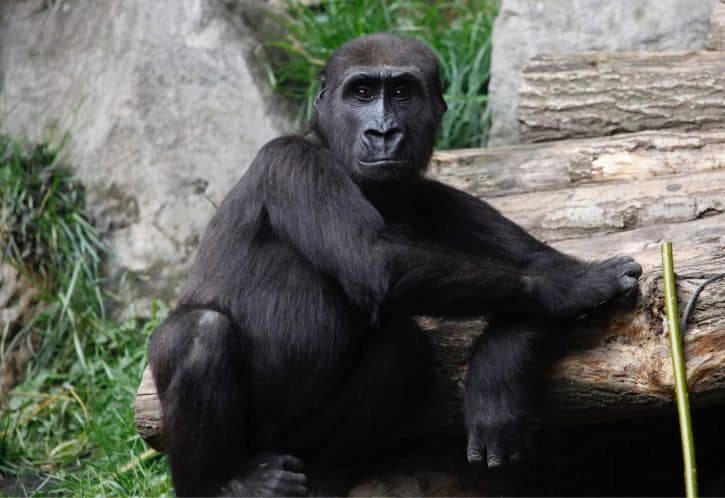
Scientific name: Pan paniscus
Also called: Pygmy chimpanzee
Classification: Animalia>Chordata>Mammalia>Primates>Haplorhini>Simiiformes>Hominidae>Homininae>Hominini>Pan
Habitat: Tropical rainforests located south of the Congo River and north of the Kasai River in the Democratic Republic of Congo (Africa)
Average lifespan: 60 years (captivity)
Average adult size: 30 inches long (nose to rump when on all fours), 3.8 feet tall when standing, weight 65 pounds (females) or 85 pounds (males)
Diet: Omnivore/frugivore (primarily fruit, then leaves, flowers, seeds, bark, honey, eggs, caterpillars, earthworms, small mammals)
Description: Bonobos are apes which share their genus with the common chimpanzee and at one point were classified as a subspecies, hence the nickname “pygmy chimpanzee.” They are covered in long, fine black hair except for their faces, ears, palms, and soles of their feet. The hair on their heads is long and parted down the middle, and they have hair on their cheeks like sideburns. On their faces are a heavy brow ridge, brown eyes, wide nostrils, and pink lips. They have large, strong hands and feet with five long fingers on each hand and five long toes on each foot.
Behavior: Bonobos spend most of their time in the tree canopy swinging from branch to branch in search of food. They primarily come down to switch to different trees, and when they walk on the ground, they walk on their knuckles and do not typically walk upright. They are highly social, peaceful apes, living in groups of up to 120 other bonobos. Smaller groups of up to 15 form from the larger groups and forage together. These groups are led by a female and her young, with adult males typically following her lead. Bonobos are capable of more complex behavior than other animals such as compassion, empathy, and patience, as observed by primatologist Frans de Waal. They can recognize themselves in the mirror and naturally communicate with each other through vocalizations, hand or foot gestures, and facial expressions. Bonobos in captivity have even been taught to use a keyboard with geographic images to respond to verbal questions.
Fun Fact: Bonobos and common chimpanzees are the closest living relatives to humans, having 98.7% of their DNA identical to ours.
Bottlenose Dolphin, Common

Scientific name: Tursiops truncatus
Also called: Atlantic bottlenose dolphin
Classification: Animalia>Chordata>Mammalia>Artiodactyla>Cetacea>Delphinidae>Tursiops
Habitat: Temperate tropical and subtropical ocean waters worldwide
Average lifespan: 17 years (wild), up to 50 years (captivity) with females living up to 10 years longer than males
Average adult size: 9.5 feet long, weight 385 pounds (males are longer and heavier than females)
Diet: Carnivore (fish, squid, eels, shrimps)
Description: Bottlenose dolphins have sleek bodies covered in smooth, rubbery skin ranging in color from dark to light gray with a whitish coloration on their bellies. Their bodies are fusiform, meaning they taper on both sides like a spindle. A bottlenose dolphin’s signature elongated snout, called a rostrum, does not function as a nose, but solely as a mouth. Their “nose” is the blowhole located on the top of their heads, which breathes air when above water and closes shut when submerged to keep water out. Completing their faces is a melon on their head, a mouth that looks like it is always smiling, and two small eyes that can move independently from each other. They have a slightly curved dorsal fin on their backs, two pectoral fins that they use for steering, and a strong, forked tailfin.
Behavior: Bottlenose dolphins are social mammals and usually live in pods of up to 25 dolphins, although groups of up to 1,000 have been spotted. They can be found hunting alone, or in small groups working together to herd schools of fish, using echolocation and their excellent vision to find prey. Using their teeth for gripping instead of chewing, they swallow their prey whole. They can remain submerged for up to 7 minutes when hunting but must come up to the surface for air; therefore, they often stay near the surface. Bottlenose dolphins produce vocalizations, communicating through high-pitched squeals and whistles, as well as body language like breaching out of the water and slapping their tails on the surface.
Fun Fact: Bottlenose dolphins don’t have the ability to breathe unconsciously like we do, especially since they must come to the surface of the water to breathe. Therefore, they allow half of their brain to sleep at a time, so the half that’s awake can remember to keep breathing!
Box Turtle, Common
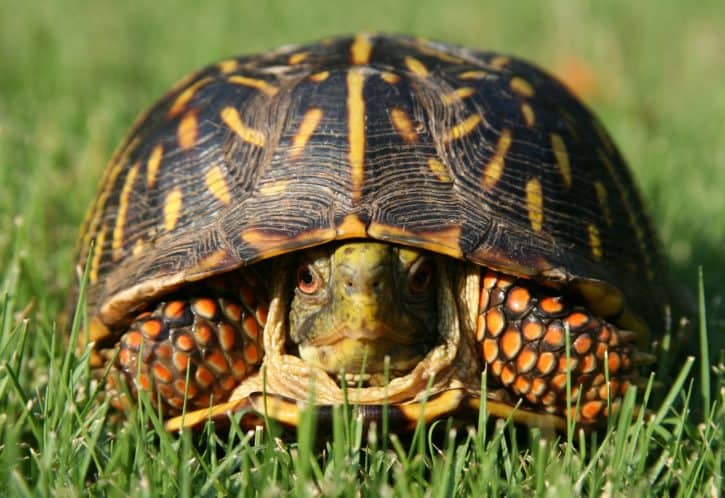
Scientific name: Terrapene carolina
Classification: Animalia>Chordata>Reptilia>Testudines>Cryptodira>Emydidae>Terrapene
Habitat: Open woodlands, meadows, marshes, swamps, grasslands and near streams and ponds in the eastern United States, southern Ontario in Canada, and along the Gulf coast and Yucatan Peninsula of Mexico
Average lifespan: 30-40 years (captivity) but there are claims that they can reach 100 years
Average adult size: Shells 6 inches x 4 inches (males are slightly larger than females)
Diet: Omnivore (worms, beetles, slugs, insects, fish, berries, grass, fungi, flowers)
Description: The shells of common box turtles are brown to dark brown, often with yellow or orange markings on the top, ranging in pattern from spots to bars to blotches depending on the subspecies. On their head, tail, arms, and legs are scales that can be brightly patterned as well. Their heads contain two large, round eyes and a slightly pointed beak. You can usually tell the males from the females by the color of their eyes; males typically have red while females have brownish yellow eyes. They have four short legs, and their front feet have five toes while their hindfeet have four toes.
Behavior: Box turtles are solitary reptiles that spend most of their time on land and are active during the day, specifically at dawn and dusk. They are named box turtles due to their uniquely domed shells, which have hinged openings allowing them to seal their head, arms, and legs up completely in their shells, like a box. By sealing up when they are frightened, they become a small fortress from predators, waiting until the threat gives up and leaves to open back up. During the summer, they come out during the morning or following the rain and are otherwise found burrowed in decaying leaves or even in shallow water to cool off. In the winter, they enter a deep state of sleep in their northern habitats, and during the spring and fall will often be out all day foraging. They have excellent vision, both during the day and at night, and a keen sense of smell.
Fun Fact: To stay cool in the summer, box turtles smear their saliva on the front of their bodies and urinate on the back parts that they can’t reach with their mouths. Gross but necessary!
Brimstone, Common
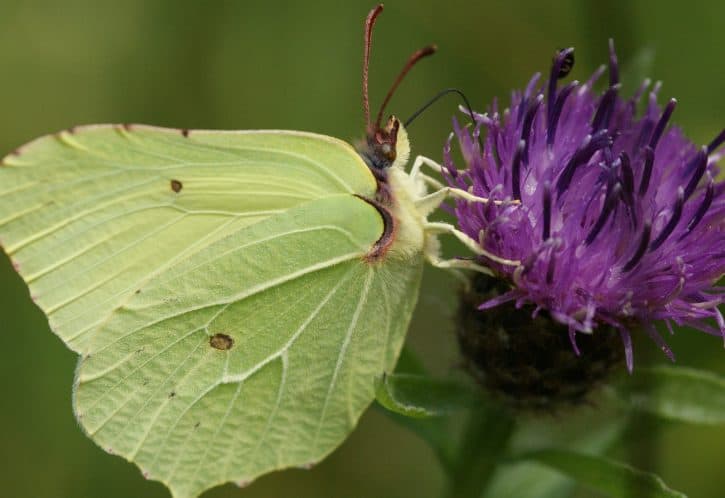
Scientific name: Gonepteryx rhamni
Classification: Animalia>Arthropoda>Insecta>Lepidoptera>Pieridae>Gonepteryx
Habitat: Wetlands (during mating/breeding), woodlands or wetlands (to hibernate), parks, gardens in Europe, east Asia to western Siberia and Mongolia, North Africa (Morocco and Algeria)
Average lifespan: Up to 11 months
Average adult size: 1.3 inches long (caterpillar), 2.3-inch wingspan (butterfly)
Diet: Herbivore/nectarivore (leaves as caterpillars, flower nectar as butterflies)
Description: Brimstones are brightly colored caterpillars and large butterflies. As caterpillars, their green bodies have short white hairs and they blend in perfectly with buckthorn leaves, the only plants their mothers will lay their eggs on. As butterflies, their yellow or green wings resemble veined leaves, providing crucial camouflage. Their wings even have two points at the edges and two small brown spots in the middle, as leaves often do, as well as small brown spots lining the edges of all wings. Males have iridescent lemon-yellow colored wings, while the wings of females are whitish green. Both sexes have brown heads and antennae, brown along their backs where their bodies connect to their wings, and thoraxes covered in fine white hairs.
Behavior: Brimstone caterpillars remain on and eat the buckthorn leaves they were born on until forming their cocoons. Once they emerge from their cocoons as butterflies, they are highly mobile and widespread throughout their ranges, feeding from June through September while searching for a perfect spot to hibernate. Due to their camouflage, they can hibernate in the open, attached to a leaf and remaining still from September through March or April.They wake from their hibernation in the spring and return to the wetlands to mate and lay eggs.Brimstones are picky about where they lay their eggs, and only do so on the common buckthorn or alder buckthorn plants.
Fun Fact: Brimstone butterflies have one of the longest lifecycles of all butterflies, and the yellow males are rumored to be the inspiration for the word butterfly (butter-colored fly).
Broad-billed Hummingbird
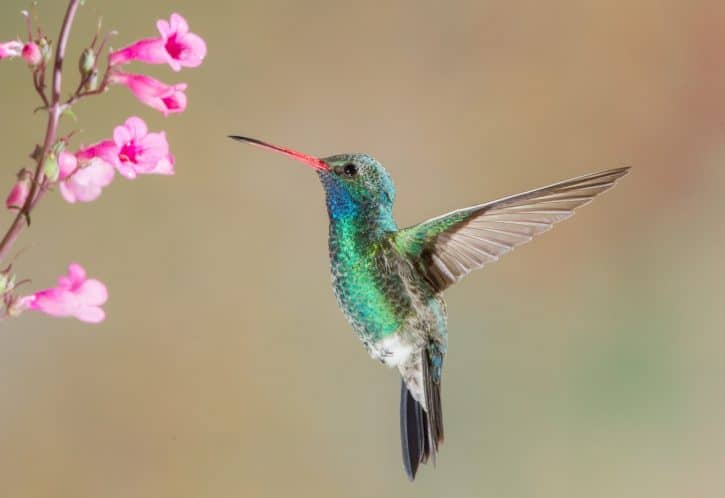
Scientific name: Cynanthus latirostris
Classification: Animalia>Chordata>Aves>Trochilidae>Cynanthus
Habitat: Canyons, foothills, and streambeds near nectar-producing plants inMexico and the southwestern United States
Average lifespan: 6 years (wild)
Average adult size: 3.5 inches long, 5-inch long wingspan, weight 3.4-3.7 grams
Diet: Omnivore/nectarivore (primarily flower nectar, then insects like aphids and leafhoppers)
Description: Broad-billed hummingbirds are small hummingbirds that have a long, slender, bright red bill tipped in black. The males have luminous green feathers on their bodies with a bright blue throat, dark gray wings, and black forked tail feathers. Females are generally less colorful with a gray throat and underparts instead of blue or green, and a small gray patch and white streak near each eye. Their dark colored feet are weak and are not used for hopping or walking, but for perching and preening only.
Behavior: Broad-billed hummingbirds are territorial when it comes to their feeding, breeding, and nesting sites. They protect these areas by clawing at intruders or striking them with their long bills. When feeding, they hover above a flower and flick their tiny, forked tongues to lap up nectar at the base, or by capturing an insect while flying about. Broad-billed hummingbirds use a large amount of energy to beat their wings so fast (up to 75 times each second!) but can enter a state called torpor to reduce their metabolic functions and conserve energy when needed. They may even hang upside down in this state, appearing as if dead.
Fun Fact: Hummingbirds are the most agile of all birds and can hover, move backward, straight up or even upside down, like tiny winged acrobats.
Brolga
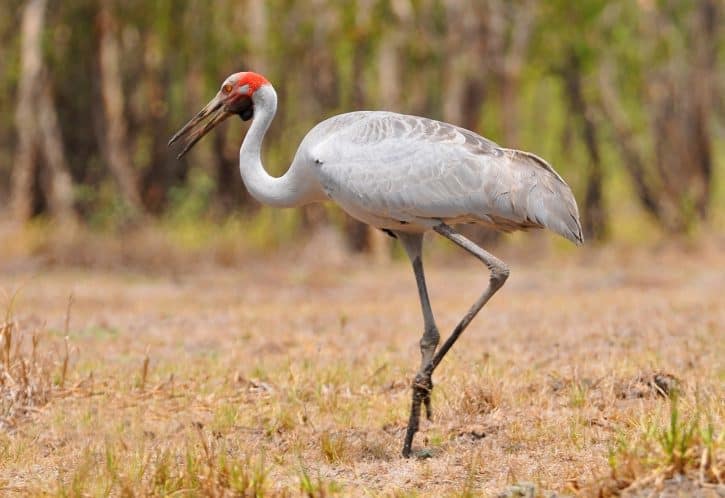
Scientific name: Antigone rubicunda
Also called: Native companion, Australian crane
Classification: Animalia>Chordata>Aves>Gruiformes>Gruidae>Antigone
Habitat: Open wetlands, coastal areas, and grassy plains in north and northeastern Australia and southern New Guinea
Average lifespan: 7 years (wild), 20 years (captivity)
Average adult size: 3.8 feet tall, 6.75-foot-long wingspan, weight 14 pounds (males are slightly larger than females)
Diet: Omnivore (tubers, shoots, leaves, grains, seeds, insects, amphibians, lizards, crustaceans, mollusks)
Description: Brolgas are tall cranes with silver-gray feathers tipped in black on the wings and tails. Their bodies are plump, supported by two long, thin legs that are dark gray. On their small, featherless heads is a silvery-gray crown and forehead, a bright red or orange patch, two large yellow eyes, a straight, bone-colored beak and a black dewlap under their chins. Brolgas have long necks that are typically observed in an S shape when at rest that allow them to reach down comfortably to the water while standing.
Behavior: Brolgas are social and are usually seen in pairs or families of up to 4 members. Following breeding season, they form large groups of up to 100 birds although the families tend to stay together within the large group. They spend their days foraging, using their beaks to dig up food, or sticking their heads underwater to hunt, and then they rest at night. They are powerful flyers and can soar to high altitudes. Brolgas are defensive of their territories and nesting sites and have been observed using their claws and beaks to fend off intruders. They are non-migratory however they are partially nomadic, relocating following a seasonal rainfall.
Fun Fact: Brolgas are famous for their elaborate courtship dances, involving head-bobbing, leaping, strutting, wing-flapping and trumpeting.
Brown Bear, Eurasian

Scientific name: Ursus arctos arctos
Also called: European brown bear, common brown bear, common bear
Classification: Animalia>Chordata>Mammalia>Carnivora>Ursidae>Ursus>Ursus arctos
Habitat: Mountain ranges and low-lying forests in northern Europe, Russia, Japan, the Himalayas (the majority are found in Russia)
Average lifespan: 20-30 years (wild), up to 50 years (captivity)
Average adult size: 3.5 feet tall (shoulder), 6 feet long/tall when standing, tail 4-5 inches long, weight 600 pounds (males) or 400 pounds (females)
Diet: Omnivore (berries, leaves, roots, nuts, fungi, honey, fruit, insects, small mammals, fish, dead animal matter)
Description: Eurasian brown bears are covered in shaggy brown fur that can be up to four inches long in the winter (shorter during the summer) and ranges in color from yellowish-brown, red-brown, or dark brown to nearly black. They have concave, wide heads with small, rounded ears, small eyes, an elongated snout, large black nose, and narrow mouth. Appearing near their shoulders like a hump is a mass of muscle, which allows them to dig so well. Eurasian brown bears have four strong legs and padded paws with long, slightly curved claws, and a short tail.
Behavior: Male Eurasian brown bears are solitary bears, while females stay with their young for 2-3 years. They can be found foraging for food in the morning and early evening and lying down to rest for the remainder of the day. While their sense of smell and hearing are keen, their eyesight is poor. When they walk, they move slowly, but despite their large size they can run up to 30 mph and are excellent swimmers. Adults cannot readily climb trees though, because of their size. During the fall, Eurasian brown bears stock up fat for winter, eating up to 90 pounds of food each day and possibly doubling their normal weight. They dig out their own dens, typically in sloped hillsides although they utilize caves and hollowed-out logs too and use them to sleep from December through March. During this winter sleep, they can lose up to 40% of their weight.
Fun Fact: Bears are often associated with hibernation; however, they don’t hibernate! Instead, they experience a winter sleep, a period of less activity which differs because they can be awoken at any point.
Brown-throated Sloth
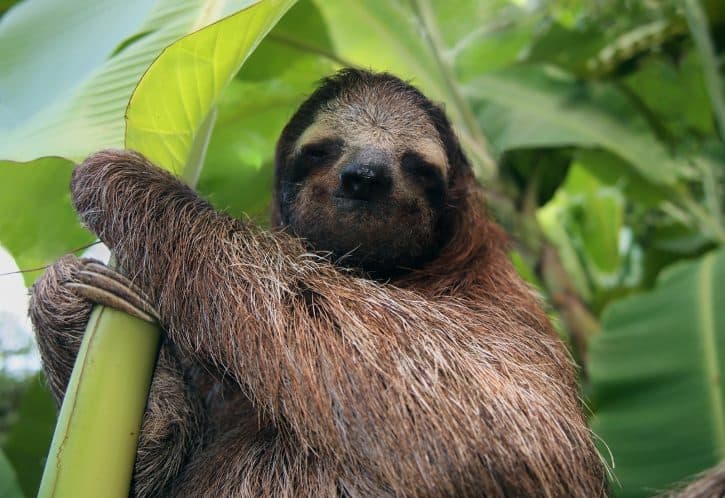
Scientific name: Bradypus variegatus
Classification: Animalia>Chordata>Mammalia>Pilosa>Bradypodidae>Bradypus
Habitat: Tropical forests in Central and South America (Honduras, Nicaragua, Panama, Bolivia, Colombia, Venezuela, Ecuador, Brazil, Peru, Paraguay)
Average lifespan: 30-40 years (wild)
Average adult size: 23 inches long, weight 9.5 pounds
Diet: Herbivore (tree leaves, flowers, and fruits)
Description: Brown-throated sloths are covered in two coats of light brown or gray fur with distinctly darker brown coloration on their throats and heads, almost like a frame for their faces. Their first coat is short and fine, while their second coat is thick and wooly. Their outermost coats are perfectly suited for hanging upside down from the trees, and funnels dripping water away from their bodies. Their fur often has a green tint to it because it is covered in algae, which helps camouflage it against the green leaves. Brown-throated sloths have dark brown stripes near their large, expressive eyes running along their cheeks, a large nose, and a mouth that looks like it is always smiling. They have long legs, with three toes and three claws on each of their four feet, which help them cling to trees as they eat or sleep.
Behavior: Brown-throated sloths are solitary, shy creatures that sleep for a good part of the day and forage for food when they wake. They spend most of their time in the tree canopy and walk awkwardly on the ground when they come down to relieve themselves. Sloths are known for being extremely slow-moving mammals which would prove unfortunate for their ability to avoid predators on land, so it’s a good thing they live in the trees. They take the risk when descending in order to support their symbiotic relationship with the algae, fungus, and moths that live on their fur. Brown-throated sloths can rotate their heads up to 300 degrees, allowing them to regularly survey their environment for predators.
Fun Fact: Not only do sloths move slow, but they also have the slowest digestion of any mammal, taking up to 2 weeks to digest a single meal. This comes in handy since they descend from their trees once a week to relieve themselves! Can you imagine finally creeping back up to the top of your tree only to have to go again?
Brush Rabbit
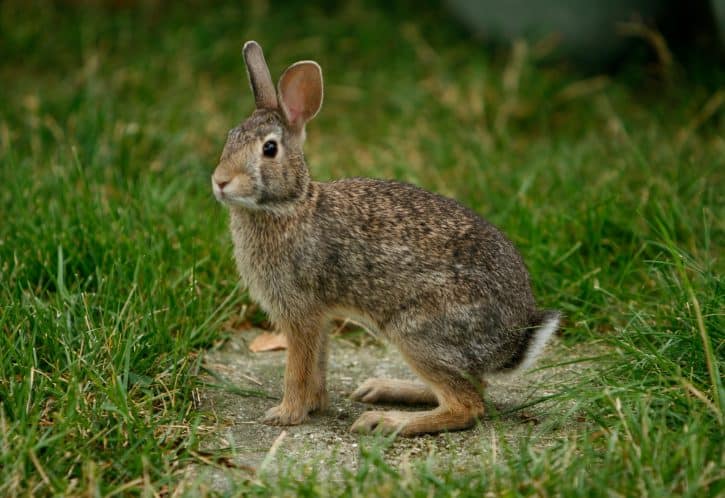
Scientific name: Sylvilagus bachmani
Also called: Western brush rabbit, California brush rabbit
Classification: Animalia>Chordata>Mammalia>Lagomorpha>Leporidae>Sylvilagus
Habitat: Dense, brushy vegetation on the western coast of North America, from Oregon in the United States to the Baja California peninsula in northern Mexico
Average lifespan: 5 years (wild)
Average adult size: 1 foot long, weight 1-2 pounds (females are slightly bigger than males)
Diet: Herbivore (grasses, clovers, thistles, leaves, twigs, berries)
Description: Brush rabbits are small to medium-sized cottontails. However, they are unique among cottontails because the bottoms of their tails are gray rather than white, which is why “cottontail” is not a part of their common name. They are covered in reddish-orange, light brown, dark gray and black fur that appears speckled, with white fur on their underside. Brush rabbits have short, wide ears that are darker on the back, large black eyes and a lightly whiskered snout. Their front legs are short, while their hind legs are larger, strong and hinged, allowing them to leap but also to thump.
Behavior: Brush rabbits are timid and primarily solitary animals that use underground tunnels to stay out of a predator’s sight. They do not dig out their own homes but instead use the abandoned burrows of other animals. Brush rabbits are most active from sunset through the early morning hours and rarely are seen outside the brushy areas they can hide in. Should a predator chase them, they will run in a zig-zag pattern at speeds up to 25 miles per hour, or climb up a tree, or jump into bushes to escape. When frightened, they thump their hind legs on the ground and squeal as a warning to other rabbits.
Fun Fact: Did you know? When rabbits are happy, they leap up in the air while twisting their bodies simultaneously. This “happy dance” is called a binky.
Buckeye

Scientific name: Junonia coenia
Also called: Common buckeye
Classification: Animalia>Arthropoda>Insecta>Lepidoptera>Nymphalidae>Junonia
Habitat: Fields, parks, meadows, and pastures in southern Canada, throughout the United States, Mexico, Central America and the Caribbean
Average lifespan: 10 days (as an adult butterfly)
Average adult size: 2 inches long (caterpillars), 2-inch wingspan (butterflies)
Diet: Herbivore/nectivore (caterpillars eat herbaceous plants while butterflies primarily eat nectar, fruit juices, or mud for salt and minerals)
Description: As caterpillars, buckeyes are black with orange spots running down the length of their bodies and are covered in small spines which are blue at the base. As butterflies, they are brown with one off-white band, one large and two small orange bands near the edge of each of their upper wings, and one large eyespot and one small eyespot. (An eyespot is a spot that resembles an eye and is useful in confusing predators into thinking they are looking at a larger animal.) Their upper wings are triangular shaped and attach to the body near the head. On their lower wings, they have scalloped edges and a larger orange band at the bottom, and two eyespots, one significantly larger than the other. Some butterflies have blue tints on the larger eyespots, particularly those found on the lower wings. The lower wings are wider and rounder than the top wings and attach to the lower part of the body. They have six legs; the legs near their heads are brush-like and short, while the rearmost four legs are used for walking. Their bodies are subtly striped in orange across their backs.
Behavior: Buckeyes begin their lives as caterpillars and remain caterpillars for up to 4 weeks, living a solitary life of eating leaves and plants. Next, they enter the pupa stage and form a chrysalis for up to 2 weeks, often sooner in the summer. Finally, the adult butterfly emerges and begins to search for nectar as soon as the wings dry. They are important pollinators and typically drink from shallow flowers when foraging. Buckeyes perch on low branches and have a quick, erratic flight pattern. Males are territorial and chase off other insects, or perch and wait for a female to fly by. As a species (since the individual butterflies don’t live long), they migrate south during the fall to avoid the cold weather and return in the spring.
Fun Fact: Did you know the buckeye’s wings change color with the seasons? During the spring and summer, when flowers are brightly colored, buckeye wings are a lighter brown. Once fall arrives, they can be seen with reddish-brown wings to blend in with the brown leaves of autumn.
Bufflehead
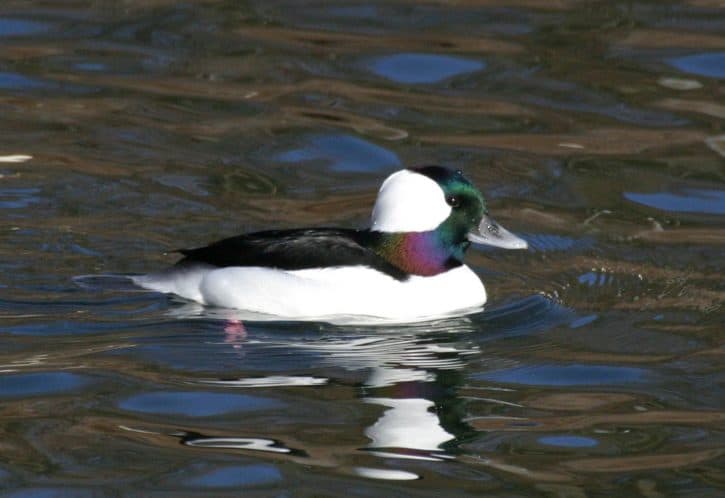
Scientific name: Bucephala albeola
Classification: Animalia>Chordata>Aves>Anseriformes>Anatidae>Bucephala
Habitat: Breed primarily in Canada and Alaska, and migratory throughout North America in sheltered coastal ocean waters or open inland water (ponds, rivers, lakes)
Average lifespan: About 2.5 years
Average adult size: 14 inches long, 22-inch wingspan, weight 1 pound (males) or 12 ounces (females)
Diet: Omnivore (Freshwater: insects, snails, worms, aquatic vegetation, fish eggs. Saltwater: crustaceans, mollusks, aquatic vegetation, fish eggs)
Description: Buffleheads are small, plump ducks covered in soft feathers, with gray bills. The plumage of males and females look quite different from each other. Males are white on the lower part of their bodies with black feathers starting in a high contrast line around the top portion, and a large, rounded, white patch wrapping around the back of their heads, starting behind their eyes. The darker feathers on the male’s heads have an iridescent quality to them, reflecting mainly shades of green and purple, but also pink and yellow. Their black eyes blend in with the black portion of their facial plumage. When they are in flight, you can see that their wings are primarily black with two thin, white stripes along the shoulder and a larger white patch running diagonally across the top of each wing. Their bright pink feet also stand out when they are flying. Females also have two-toned bodies; however, instead of white, their bottom half is light gray. Their top half, including their heads, is black, with a small white patch running horizontally across their cheek. When they fly, you can see a single white spot on each wing and that they have much darker feet than the males, ranging from black to a dark pink color.
Behavior: While they are social birds, buffleheads prefer small groups of up to 10 and are not found in large flocks. When feeding, they dive underwater at depths of up to 15 feet, capture prey or vegetation, eat on the way back up to the surface, rest for less than a minute, and do it all over again. One bufflehead will usually watch out for predators while the others hunt. When they are not hunting, they spend their days preening, swimming and sleeping. They don’t spend much time on dry land and waddle awkwardly when they do because their legs are located towards the back of their bodies. When they are ready to fly, they take flight from the water and make their nests in the abandoned nest holes of the Northern Flicker, a species of woodpecker. These nests are readily available because not too many other birds are small enough to fit in them.
Fun Fact: Buffleheads are the smallest diving ducks in North America, and tied with the green-winged teal duck for the title of America’s smallest duck.
Buff-tailed Bumblebee
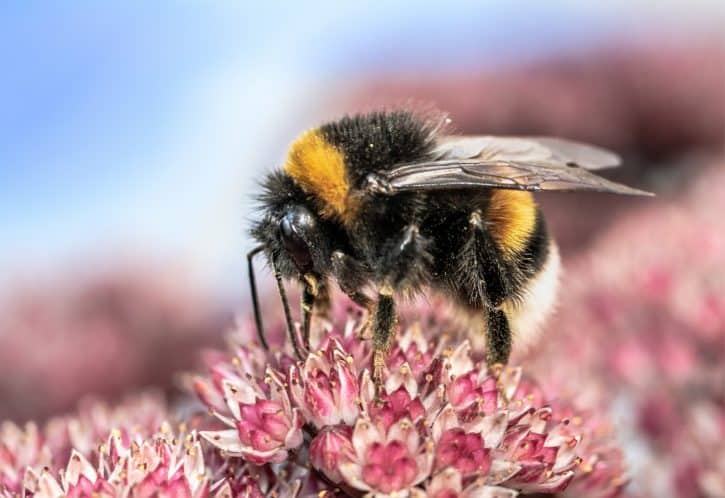
Scientific name: Bombus terrestris
Also called: Large earth bumblebee
Classification: Animalia>Arthropoda>Insecta>Hymenoptera>Apidae>Bombus>Bombus
Habitat: Gardens and parks in lowland areaswith temperate climates throughout Europe, although this species is used in greenhouse pollination and has been exported all over the world for that purpose
Average lifespan: 2-3 months
Average adult size: 2.2 cm long (queen), 1.4 cm long (female worker), 1.5 cm long (male drone)
Diet: Herbivore (primarily nectar and pollen, occasionally honey)
Description: Buff-tailed bumblebees are large, oval-shaped bees covered in fine hair, with alternating dark yellow and black bands. They have two dark, translucent wings on their backs that are shaped like rounded leaves and six strong legs that are also hairy, the hind legs being thicker than the front legs. On their heads are two short antennae, a small mouth, and large black eyes. Instead of a white tail like the rest of the colony, the queen is the only one with a buff (off-white to light brown) tail and is bigger than all other bees in the colony. The worker bees and male drones have white hair on the end of their bodies, resembling a tiny white diaper. These workers look like their cousins, the white-tailed bumblebees, and can only truly be told apart by examining them side-by-side (buff-tailed have darker yellow stripes while white-tailed stripes are lemon yellow).
Behavior: Each colony has a set dynamic with three roles to play, ensuring the success of the whole colony. The first role is the queen, which is responsible for mating with a single male, then finding a location to build a nest, and reproducing in order to build her colony’s population. She searches for a safe place to nest underground and may take over an area abandoned by another animal, particularly mice. She cares for her larvae until they are adults. The second role is performed by the male bees, called drones, which forage for themselves and are only responsible for mating. The queen’s male offspring will leave the nest once they reach adulthood, searching for other queen bees to mate with. The queen’s female offspring become worker bees, which perform the third role of the colony. The larger workers are responsible for foraging for food and bringing it back to the colony, while the smaller workers defend the nest and care for the queen’s larvae. Colonies typically contain 300-400 bees. When foraging, buff-tailed bumblebees are naturally drawn to blue or yellow flowers. They have short tongues and therefore mainly choose shallow flowers they can reach down into. At times they are even seen biting a hole in the side of deeper flowers to access the nectar, bypassing the pollen completely so that flower doesn’t get pollinated.
Fun Fact: Did you know that buff-tailed queens and worker bees have amazing bodies with built-in storage? It’s true! They have little “baskets” for pollen on the back of each rear leg, allowing them to carry large quantities back to their nests.
Bullet Ant
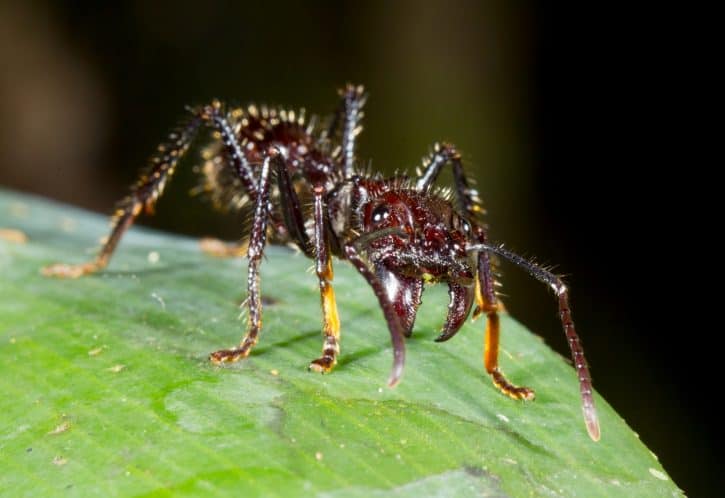
Scientific name: Paraponera clavate
Also called: 24-hour ant, big black ant
Classification: Animalia>Arthropoda>Insecta>Hymenoptera>Formicidae>Paraponerinae>Paraponerini>Paraponera
Habitat: Lowland rainforests in Central America (Nicaragua, Honduras, Costa Rica, Panama) and South America (Colombia, Venezuela, Ecuador, Peru, Bolivia, Brazil)
Average lifespan: About 90 days (workers), 1-3 years (queen)
Average adult size: 1-1.2 inches long (the queen is roughly the same size as workers)
Diet: Omnivore (nectar, sap, small insects like termites and crickets, larvae)
Description: Bullet ants are the hairiest ants in the world and amongst the largest ants as well. They have reddish-black bodies in the three sections that classify them as insects (head, thorax, and abdomen), six thin legs, and two long, hinged antennae on their heads. Their famous stinger is located at the rear of their abdomens, and their mandibles are large enough to be noticeable by a human eye. They have been described as having the body of a wasp without the wings.
Behavior: Bullet ants live in colonies with hundreds of other ants, each group of which have different roles to play for the good of the colony. Worker ants collect nectar or insects in their mandibles and bring it back to the nest to share, soldier ants defend tunnel entrances against intruders, while the queen ant and her drones keep the colony population thriving by reproducing. Bullet ants make their nests at the bottom of trees, seemingly preferring what are called buttress roots. Workers forage up in the trees instead of on the ground, and don’t often travel far from the trees closest to their nests. Despite their famous sting, they are not aggressive towards humans and sting in defense of their colony. They are highly territorial towards other bullet ants though and fiercely protect their nests.
Fun Fact: Bullet ants are famous for producing what many unfortunate people call the world’s most painful insect sting. They say it feels like they have been shot with a gun, hence the name. The intense pain can lead to temporary paralysis and may last up to 24 hours. In all fairness, they do emit a kind of warning to their potential victims: an odor just before they sting.
Bull Shark
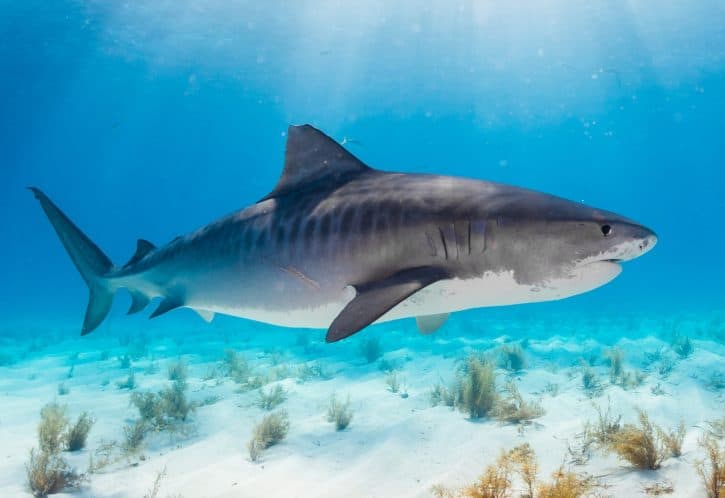
Scientific name: Carcharhinus leucas
Also called: Zambezi shark, Ganges River shark, van Rooyen’s shark, Lake Nicaragua shark, river shark, freshwater shark, estuary whaler, Swan River whaler, cub shark, shovelnose shark
Classification: Animalia>Chordata>Chondrichthyes>Carcharhiniformes>Carcharhinidae>Carcharhinus
Habitat: Worldwide in warm, shallow ocean waters near coasts, or in rivers, streams, and estuaries (depth range 98-490 feet)
Average lifespan: 16 years (wild), 25 years (captivity)
Average adult size: 7.5 feet long and weighs 210 pounds (males), 8 feet long and weighs 290 pounds (females)
Diet: Carnivore (fish, stingrays, small sharks, mollusks, turtles, birds, dolphins)
Description: Bull sharks have short, stocky bodies covered in light gray skin, with a white belly. They have two triangular dorsal fins on their backs (one big and one small), 4-5 gills on each side of their heads, two large pectoral fins, three small fins underneath at the rear of their bodies, and a large tailfin. On their faces are a short, blunt snout, small eyes, and the strongest shark jaws that have ever been measured. Bull shark teeth are triangular shaped, extremely sharp, and serrated. They have approximately 350 teeth, set in rows of up to 50 per row.
Behavior: Bull sharks are generally solitary hunters (occasionally they hunt in pairs) and are known for their aggressive nature. They prefer to hunt in murky water so they can sneak up on prey undetected, partially because their eyesight is poor compared to other sharks. Relying on their keen sense of smell and hearing instead to locate prey, they charge towards it at speeds of up to 25 mph and may bump into it before taking a bite. Bull sharks are unique in that they thrive in both saltwater and freshwater and have been observed swimming far up rivers, including the Mississippi River in North America, Lake Nicaragua in Central America, Amazon River in South America, Zambezi River in Africa and Ganges River in Asia.
Fun Fact: Bull sharks earned their name because of their stocky bodies and aggressive nature. They are one of the most dangerous sharks to humans when you combine their preference for shallow waters, zero-tolerance attitude towards intruders, and incredibly powerful jaws.
Burchell’s Zebra
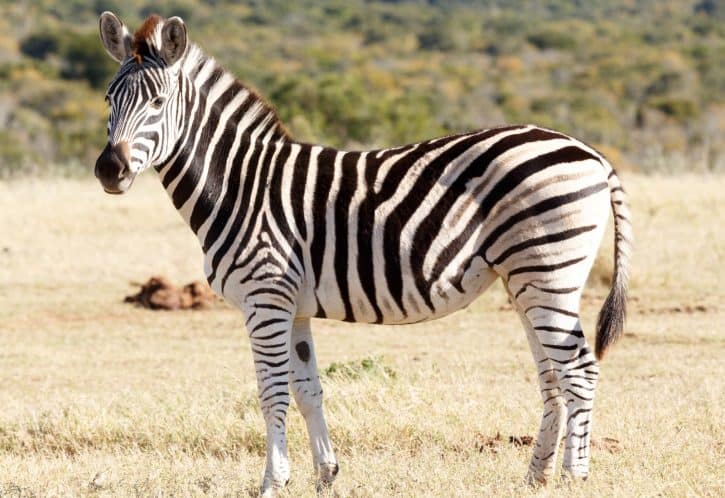
Scientific name: Equus quagga burchellii
Also called: Bontequagga, Damara zebra, Zululand zebra
Classification: Animalia>Chordata>Mammalia>Perissodactyla>Equidae>Equus>Equus quagga
Habitat: Open savannas in southeast Africa (highest concentration found in Kenya and Tanzania), except for deserts, wetlands, and dense forests
Average lifespan: 9 years (wild), up to 40 years (captivity)
Average adult size: Body 7.5 feet long, 4 feet tall (shoulder), 1.6 foot-long tail, weight about 520 pounds
Diet: Herbivore (primarily grasses, then shrubs, herbs, leaves, and twigs)
Description: This subspecies of the plains zebra was discovered by 19th-century British explorer William John Burchell. They are distinguishable from other zebra by the presence of one or two gray shadow stripes between the two larger stripes on their flanks. They are mainly white, with vertical black (sometimes brown) stripes, running down their necks, becoming diagonal in their midsection and horizontal on their haunches and legs. Burchell’s zebras have thin stripes on their faces, both horizontally and vertically, creating patterns. Each zebra has unique striping, like a human fingerprint. The stripes seem to fade away on the insides of their legs and the closer you get to their hooves. They have manes that are short and are striped with alternating white and black hair that sticks straight up.
Behavior: Burchell’s zebras live in small family groups of one male, 1-6 females, and their young. Should the stallion of the group leave or be killed, the harem will search for a new stallion to take his place, remaining together with the other females and their young. Young males and unattached stallions form bachelor groups of up to 16 males; however, the average bachelor group is only a few members strong. Burchell’s zebra graze on grass during the day and remain in their group when sleeping, with one zebra staying awake to keep watch for predators. Should a predator show up, they use a specific predator call to warn the rest of the group of the threat. They also have one call to indicate an injury and another to indicate distress.
Fun Fact: Burchell’s zebras hold the record for the longest migrating land animal in Africa, traveling up to 160 miles each way, typically in a straight north-south direction.
Burgundy Snail

Scientific name: Helix pomatia
Also called: Roman snail, edible snail, escargot, big white, vineyard snail
Classification: Animalia>Mollusca>Gastropoda>Heterobranchia>Euthyneura>Eupulmonata>Stylommatophora>Sigmurethra>Helicidae>Helix
Habitat: Forests, gardens, parks, vineyards, or near rivers in central and southeastern Europe
Average lifespan: 10-20 years
Average adult size: 4 inches long (soft body), about 2 inches tall (shell)
Diet: Herbivore (fruits, vegetables, leaves, flowers, tree sap)
Description: Burgundy snails are large snails with delicately banded, coiled shells that are a light brown or cream color, with darker reddish-brown stripes. The shells take up about 1/3 of their body weight and contain a large, white opening with four or five spirals, which are used to protect the soft body (during self-defense and hibernation) and internal organs of the snail. The soft body of burgundy snails is a mottled cream and brown color and contains two sets of tentacles on their heads: the longer ones on the top for seeing, and the shorter ones below used to smell.
Behavior: Burgundy snails prefer mild climates with high humidity and are not found in overly sunny or rainy places. They search for food during the night, often between sunset and midnight, to avoid the heat of the day. They move about on a single foot, slowly sliding along self-produced mucus on rough terrain, or “jumping” on dry ground to reduce water loss. (To learn more about how snails move, check this website out.) It’s a good thing they leave a trail because they use it to find their way back home and may follow it again the next day to feed. The mucus also aids in reducing friction and damage to their soft bodies. Burgundy snails need loose soil to burrow into and lay eggs, but also to hibernate in safely during the winter. During hibernation, they create a tight door for their shell to protect them from the elements and predators.
Fun Fact: Burgundy snails are called escargots once they are cooked in fancy restaurants, where they are considered a fine delicacy. Although some people are grossed out by the thought of eating snails, they have been consumed by humans since ancient times.
Burmese Python
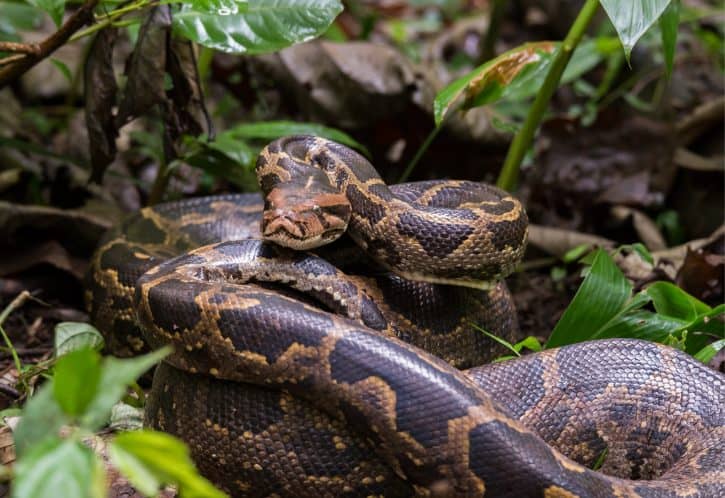
Scientific name: Python bivittatus
Classification: Animalia>Chordata>Reptilia>Squamata>Serpentes>Pythonidae>Python
Habitat: Grasslands, marshes, swamps, woodlands, jungles in southern and southeast Asia (eastern India, Nepal, Bhutan, Bangladesh, Myanmar, Thailand, Cambodia, Laos, Vietnam, Malaysia, southern China)
Average lifespan: 20-25 years
Average adult size: 12-23 feet long, weighs up to 200 pounds
Diet: Carnivore (birds and mammals like rodents, although large snakes will eat pigs, deer or even juvenile alligators)
Description: Burmese pythons are light brown to cream-colored with dark brown blotches lined in black covering their scaled, limbless bodies almost like a honeycomb pattern. This pattern fades on their whitish underside. Their lengthy bodies are heavy and taper at each end. Burmese pythons have triangular heads with two distinct lines running from their nostrils to the back of their heads before blending in with their bodies. Since they are non-venomous, they have no need for fangs and instead have rows of sharp teeth that curve back towards their mouths, perfectly suited for gripping rather than chewing.
Behavior: Burmese pythons are non-venomous, solitary snakes that spend most of their time on the ground once they are full-grown, due to their size and weight. They are excellent swimmers though, capable of remaining submerged for up to 30 minutes before coming up for air. Their eyesight is poor, so they rely on chemical receptors in their tongues and heat sensors along their jaws when hunting at night. Once they locate prey, they grab it with their sharp teeth and wrap their thick bodies around it, squeezing until the blood supply is cut off. Then they expand their jaws and bodies to eat their prey whole.
Fun Fact: Burmese pythons are popular pets among large reptile enthusiasts and are bred to yield snakes with different patterns and coloration, called morphs. However, things can go very wrong when these pets get released into the wild, as demonstrated by the proliferation of Burmese pythons in the Florida Everglades.
Burrfish

Scientific name: Chilomycterus schoepfi
Also called: Striped burrfish, spiny box puffer
Classification: Animalia>Chordata>Actinopterygii>Tetraodontiformes>Diodontidae> Chilomycterus
Habitat: Primarily seagrass beds found in tropical bays and lagoons, or in coral reefs, from the northern Gulf of Mexico down to the Brazilian coast, although some have been spotted as far north as the shores of Nova Scotia, Canada (depth range: usually within 30 feet of the surface)
Average lifespan: Unknown
Average adult size: Up to 10 inches long
Diet: Primarily a carnivore (small fish, snails, shrimp, oysters, hermit crabs, barnacles) but occasionally they eat algae
Description: Burrfish have box-shaped bodies, which are completely covered in pointy, yellow or orange spikes. Their bodies are tan or yellow, typically with dark brown stripes although the top of the body, although some burrfish sport a honeycomb pattern instead. Between 5-7 dark spots are visible on the back part of their bodies, at the bottom of the dorsal fin and near the pectoral fins. The underside of their bodies is lighter in color, often white or cream-colored, and does not have stripes or patterns. Burrfish have bulging yellow eyes that are set far apart on their large heads. A strong, beak-like mouth containing only two teeth allows them to successfully hunt animals with tough exterior shells, which they sometimes eat whole. They have thin, yellow, see-through fins that are larger and fan-shaped at their sides and smaller at the rear of their bodies.
Behavior: Burrfish are part of the porcupinefish family and can likewise puff their bodies up in self-defense; however, they differ from their cousins in that they cannot move their spikes, which are always stiff. When they puff up, they fill their bodies with water and can be twice their original size, resembling a large, round burr. They are solitary hunters, searching for their food at night while blending in with the ocean floor. Instead of bending their bodies as many fish do, they swim about by coordinating the movements of their pectoral fins and tailfin, or by expelling water from their bodies to propel forward.
Fun Fact: Although puffing up their bodies proves to be a great form of self-defense so that they have very few predators, burrfish cannot do anything else while in this state and must deflate before being able to swim away.
Bush Dog
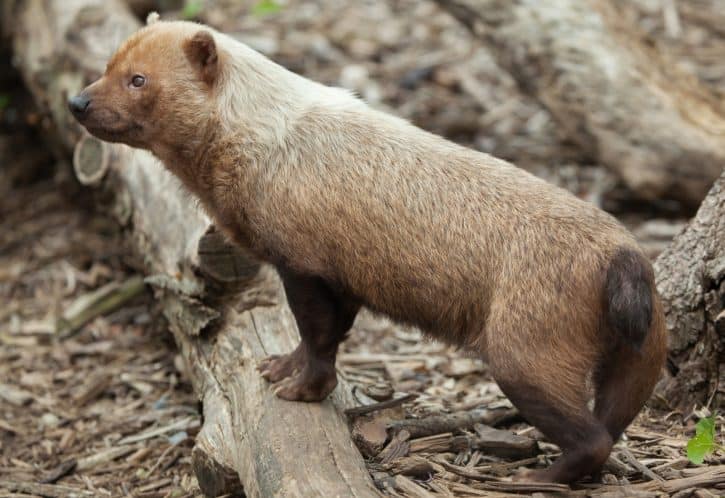
Scientific name: Speothos venaticus
Also called: Vinegar dog, vinegar fox, water dog, mountain dog
Classification: Animalia>Chordata>Mammalia>Carnivora>Canidae>Speothos
Habitat: Lowland forests near water, and wet savannas in Central America (Costa Rica and Panama), and throughout South America (mainly in Guyana, Suriname, and Peru)
Average lifespan: 10 years (captivity)
Average adult size: Body 26 inches long, 5.5-inch-long tail, weight about 15 pounds
Diet: Carnivore (large rodents like agoutis and pacas, and lizards, birds, and snakes)
Description: Bush dogs have soft brown fur covering their bodies, with darker, nearly black hair on their underside, including their legs and bushy tails. Their coats can range in color from tan to dark brown, sometimes fading from one shade to the next, and they often have lighter patches of hair on their heads, back, neck and throats. They have a small face with short, rounded ears, and four short legs with semi-webbed toes, allowing them to move swiftly in the water and earning them the nickname “water dog.”
Behavior: Bush dogs often hunt alone or in groups of two during the day but can be found in a pack of up to 12. When operating as a pack, they split up, with some dogs chasing prey while others wait in the water to block the prey’s exit. They communicate with each other using a range of contact calls since the forest makes it difficult to see each other. At night, they find a hollow tree or an empty armadillo burrow to sleep in.
Fun Fact: At one point, scientists believed bush dogs had already gone extinct, and all that was known about them was based on fossil records. Even now, they are elusive and rarely spotted in the wild, making information about them scarce.
Bush Pig
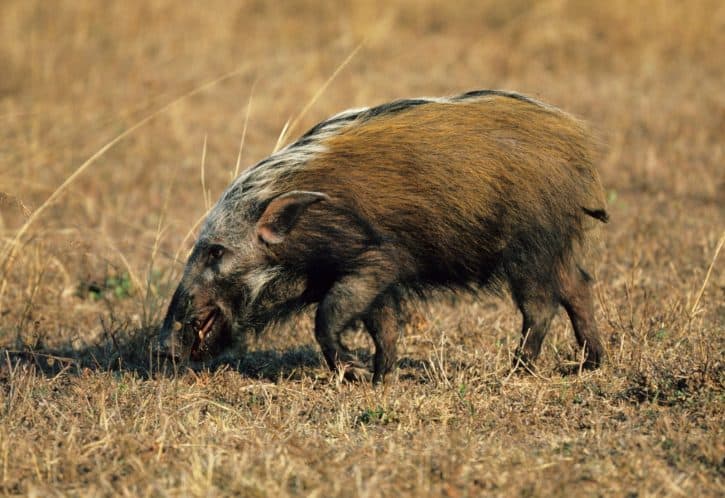
Scientific name: Potamochoerus larvatus
Classification: Animalia>Chordata>Mammalia>Artiodactyla>Suidae>Potamochoerus
Habitat: Dense forests, woodlands, and reedbeds in sub-Saharan Africa, and likely introduced by man in Madagascar, Comoro, and the Mayotte Islands
Average lifespan: 20 years
Average adult size: 32 inches tall (shoulder), about 4 feet long, weight 225 pounds
Diet: Omnivore (roots, seeds, tubers, fungi, fruit, worms, insects, eggs, dead animals)
Description: Bush pigs have long, shaggy coats of hair covering their bodies, ranging in color from gray to reddish-brown to black. They have rounded bodies, thin tufted tails, and four short legs punctuated by broad hooves. On their heads are triangular ears with long tufts of hair at the ends, elongated snouts with two sets of tusks, and small eyes. They have light-colored, rough hair on the backs of their necks that runs down the length of their spines and stands up if they are feeling defensive. Males are slightly bigger than females, but both sexes have tusks.
Behavior: Bush pigs are social animals and live in groups of up to 12 pigs, led by a dominant male and a dominant female.They are nocturnal animals and sleep during the day under cover of vegetation or in burrows. (It is believed that this is so they can avoid the daytime sun.) At night, they forage for food with their long snouts and have been found to steal and damage crops from local farmers. They are territorial and can be very aggressive, using their sharp tusks to ward off any threats to their young or their territory. They communicate by growling if a predator is nearby and make soft grunts when foraging. Bush pigs love to wallow (roll around or lie down) in the dirt or mud, probably to keep cool.
Fun Fact: It may not seem like it at first glance, but bush pigs have small, sharp tusks near their snouts. Their long hair can keep them hidden from sight, making it a sort of secret weapon to use against threats.
Hi my name is C.B. Daniels and I make websites. I’ve also always been fascinated by animals. I thought that some of the information about animal diets and pet names was a little thin. So I figured I’d make this site to remedy that! I hope to make this site a hub for information about what animals eat, fun names you can use for your pets, and general animal information. Hopefully, you’ll find all the information about animals you are looking for and much more!
Latest posts by C.B. Daniels (see all)
- Can Rabbits Eat Grapes? - November 12, 2022
- Can Rabbits Eat Cucumbers? - November 3, 2022
- Can Rabbits Eat Spinach? - November 3, 2022